
List of English Heritage properties
Encyclopedia
English Heritage. is an executive non-departmental public body
of the British Government sponsored by the Department for Culture, Media and Sport
(DCMS). By caring for the built environment
, English Heritage complements the work of Natural England
which aims to protect the natural environment
. It has a broad remit of managing the historic built environment of England and advises the relevant Secretary of State
on policy and in individual cases such as registering listed buildings and scheduled ancient monument
s.
It was set up under the terms of the National Heritage Act 1983. Its functions for maintaining ancient monuments had previously been undertaken by part of the Department of the Environment
which was the successor to the Ministry of Works. English Heritage's best known role is as the steward of over 400 significant historical and archaeological sites, from Stonehenge
to the world's earliest iron bridge
. It has direct ownership over some historic sites and also liaises with private owners of sites that are managed under guardianship arrangements. It has major responsibilities in conservation, giving advice, registering and protecting the historic environment. It also maintains a public archive, the National Monuments Record (NMR).
This page provides a list of English Heritage Properties in England, and is a link page for any stately home
, historic house
, castle
, abbey
, museum
or other property in the care of English Heritage
.
Non-departmental public body
In the United Kingdom, a non-departmental public body —often referred to as a quango—is a classification applied by the Cabinet Office, Treasury, Scottish Government and Northern Ireland Executive to certain types of public bodies...
of the British Government sponsored by the Department for Culture, Media and Sport
Department for Culture, Media and Sport
The Department for Culture, Media and Sport is a department of the United Kingdom government, with responsibility for culture and sport in England, and some aspects of the media throughout the whole UK, such as broadcasting and internet....
(DCMS). By caring for the built environment
Built environment
The term built environment refers to the human-made surroundings that provide the setting for human activity, ranging in scale from personal shelter and buildings to neighborhoods and cities that can often include their supporting infrastructure, such as water supply or energy networks.The built...
, English Heritage complements the work of Natural England
Natural England
Natural England is the non-departmental public body of the UK government responsible for ensuring that England's natural environment, including its land, flora and fauna, freshwater and marine environments, geology and soils, are protected and improved...
which aims to protect the natural environment
Natural environment
The natural environment encompasses all living and non-living things occurring naturally on Earth or some region thereof. It is an environment that encompasses the interaction of all living species....
. It has a broad remit of managing the historic built environment of England and advises the relevant Secretary of State
Secretary of State (United Kingdom)
In the United Kingdom, a Secretary of State is a Cabinet Minister in charge of a Government Department ....
on policy and in individual cases such as registering listed buildings and scheduled ancient monument
Scheduled Ancient Monument
In the United Kingdom, a scheduled monument is a 'nationally important' archaeological site or historic building, given protection against unauthorized change. The various pieces of legislation used for legally protecting heritage assets from damage and destruction are grouped under the term...
s.
It was set up under the terms of the National Heritage Act 1983. Its functions for maintaining ancient monuments had previously been undertaken by part of the Department of the Environment
Department for Environment, Food and Rural Affairs
The Department for Environment, Food and Rural Affairs is the government department responsible for environmental protection, food production and standards, agriculture, fisheries and rural communities in the United Kingdom...
which was the successor to the Ministry of Works. English Heritage's best known role is as the steward of over 400 significant historical and archaeological sites, from Stonehenge
Stonehenge
Stonehenge is a prehistoric monument located in the English county of Wiltshire, about west of Amesbury and north of Salisbury. One of the most famous sites in the world, Stonehenge is composed of a circular setting of large standing stones set within earthworks...
to the world's earliest iron bridge
The Iron Bridge
The Iron Bridge crosses the River Severn at the Ironbridge Gorge, by the village of Ironbridge, in Shropshire, England. It was the first arch bridge in the world to be made out of cast iron, a material which was previously far too expensive to use for large structures...
. It has direct ownership over some historic sites and also liaises with private owners of sites that are managed under guardianship arrangements. It has major responsibilities in conservation, giving advice, registering and protecting the historic environment. It also maintains a public archive, the National Monuments Record (NMR).
This page provides a list of English Heritage Properties in England, and is a link page for any stately home
Stately home
A stately home is a "great country house". It is thus a palatial great house or in some cases an updated castle, located in the British Isles, mostly built between the mid-16th century and the early part of the 20th century, as well as converted abbeys and other church property...
, historic house
Historic house
A historic house can be a stately home, the birthplace of a famous person, or a house with an interesting history or architecture.- Background :...
, castle
Castle
A castle is a type of fortified structure built in Europe and the Middle East during the Middle Ages by European nobility. Scholars debate the scope of the word castle, but usually consider it to be the private fortified residence of a lord or noble...
, abbey
Abbey
An abbey is a Catholic monastery or convent, under the authority of an Abbot or an Abbess, who serves as the spiritual father or mother of the community.The term can also refer to an establishment which has long ceased to function as an abbey,...
, museum
Museum
A museum is an institution that cares for a collection of artifacts and other objects of scientific, artistic, cultural, or historical importance and makes them available for public viewing through exhibits that may be permanent or temporary. Most large museums are located in major cities...
or other property in the care of English Heritage
English Heritage
English Heritage . is an executive non-departmental public body of the British Government sponsored by the Department for Culture, Media and Sport...
.
| Bedfordshire Berkshire Bristol and Bath Buckinghamshire Cambridgeshire Cheshire Co. Durham Cornwall Cumbria Derbyshire Devon Dorset DurhamEast Riding of Yorkshire East Sussex Essex Gloucestershire Hampshire Herefordshire Hertfordshire Isle of Wight Isles of Scilly Kent Lancashire Leicestershire Lincolnshire London Norfolk Northamptonshire Northumberland North Yorkshire Nottinghamshire Oxfordshire Redcar and Cleveland Rutland Shropshire Somerset South Yorkshire Staffordshire Suffolk Surrey Tyne and Wear Warwickshire West Midlands West Sussex West Yorkshire Wiltshire Worcestershire See also References |
Bedfordshire
| Name |
Type |
Date |
Condition |
Image | Notes |
|---|---|---|---|---|---|
| Bushmead Priory Bushmead Priory The Priory Church of Saint Mary, Bushmead, commonly called Bushmead Priory, was a monastic foundation for Augustinian Canons, located at Bushmead in the County of Bedfordshire in England... |
Priory Priory A priory is a house of men or women under religious vows that is headed by a prior or prioress. Priories may be houses of mendicant friars or religious sisters , or monasteries of monks or nuns .The Benedictines and their offshoots , the Premonstratensians, and the... |
1185-95 | Part complete | The Priory Church of Saint Mary, Bushmead, commonly called Bushmead Priory, was a monastic foundation for Augustinian Canons, located at Bushmead in the County of Bedfordshire in England. | |
| De Grey Mausoleum De Grey Mausoleum The de Grey Mausoleum in Flitton, Bedfordshire, England, is one of the largest sepulchral chapels in the country. It is a Grade I listed building... |
Mausoleum Mausoleum A mausoleum is an external free-standing building constructed as a monument enclosing the interment space or burial chamber of a deceased person or persons. A monument without the interment is a cenotaph. A mausoleum may be considered a type of tomb or the tomb may be considered to be within the... |
1614 | Complete | 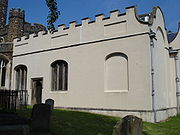 |
The de Grey Mausoleum in Flitton, Bedfordshire, England, is one of the largest sepulchral chapels in the country. |
| Houghton House Houghton House Houghton House is a ruined house located near Houghton Conquest in Bedfordshire, on the ridge just north of Ampthill, and about 8 miles south of Bedford. It is a Grade I listed building.... |
Manor House Manor house A manor house is a country house that historically formed the administrative centre of a manor, the lowest unit of territorial organisation in the feudal system in Europe. The term is applied to country houses that belonged to the gentry and other grand stately homes... |
1615 | Ruins |  |
Houghton House is a ruined house located near Houghton Conquest in Bedfordshire, on the ridge just north of Ampthill, and about 8 miles south of Bedford. The house was built for the writer, translator, and literary patron Mary Sidney Herbert, Dowager Countess of Pembroke. |
| Wrest Park House and Gardens | Manor House Manor house A manor house is a country house that historically formed the administrative centre of a manor, the lowest unit of territorial organisation in the feudal system in Europe. The term is applied to country houses that belonged to the gentry and other grand stately homes... |
1834-39 | Complete |  |
Wrest Park is a country estate located near Silsoe, Bedfordshire, England. It comprises Wrest Park, a Grade I listed country house, and Wrest Park Gardens, also Grade I listed, formal gardens surrounding the mansion. |
Berkshire
| Name |
Type |
Date |
Condition |
Image | Notes |
|---|---|---|---|---|---|
| Donnington Castle Donnington Castle Donnington Castle is a ruined medieval castle, situated in the small village of Donnington, just north of the town of Newbury in the English county of Berkshire.- History :... |
Castle Castle A castle is a type of fortified structure built in Europe and the Middle East during the Middle Ages by European nobility. Scholars debate the scope of the word castle, but usually consider it to be the private fortified residence of a lord or noble... |
1386 | Ruins | Donnington Castle is a ruined medieval castle, situated in the small village of Donnington, just north of the town of Newbury. It was destroyed in the English Civil War in 1646 |
Bristol & Bath
| Name |
Type |
Date |
Condition |
Image | Notes |
|---|---|---|---|---|---|
| Sir Bevil Grenville's Monument Sir Bevil Grenville's Monument Sir Bevil Grenville's Monument is a monument erected on Lansdowne Hill, Bath, England, to commemorate the heroism of Sir Bevil Grenville and his Cornish pikemen at the Battle of Lansdowne, 1643... |
Monument Monument A monument is a type of structure either explicitly created to commemorate a person or important event or which has become important to a social group as a part of their remembrance of historic times or cultural heritage, or simply as an example of historic architecture... |
1720 | Complete | 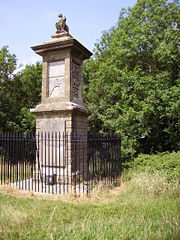 |
Sir Bevil Grenville's Monument is a monument erected on Lansdowne Hill, Bath, to commemorate the heroism of Sir Bevil Grenville and his Cornish pikemen at the Battle of Lansdowne in 1643 |
| Stanton Drew Circles and Cove Stanton Drew stone circles The Stanton Drew stone circles are at just outside the village of Stanton Drew, Somerset. The largest stone circle is the Great Circle, 113 m in diameter and the second largest stone circle in Britain... |
Henge Henge There are three related types of Neolithic earthwork which are all sometimes loosely called henges. The essential characteristic of all three types is that they feature a ring bank and ditch but with the ditch inside the bank rather than outside... |
Neolithic Neolithic The Neolithic Age, Era, or Period, or New Stone Age, was a period in the development of human technology, beginning about 9500 BC in some parts of the Middle East, and later in other parts of the world. It is traditionally considered as the last part of the Stone Age... |
Fragments | 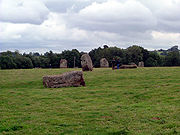 |
Located just outside the village of Stanton Drew, Somerset. The largest stone circle is the Great Circle, the second largest stone circle in Britain (after Avebury). The Great Circle probably consisted of 30 stones, of which 27 survive today, and was surrounded by the ditch of a henge. The North East Circle is 30 m in diameter and probably consisted of 10 or more stones, of which 9 are individually recognisable. The South West Circle is 40 m in diameter, and probably had more stones than the North East Circle, as it is larger in size. |
| Stoney Littleton Long Barrow Stoney Littleton Long Barrow The Stoney Littleton Long Barrow is a Neolithic chambered tomb with multiple burial chambers, located near the village of Wellow, Somerset. It is an example of the Severn-Cotswold tomb.... |
Tumulus Tumulus A tumulus is a mound of earth and stones raised over a grave or graves. Tumuli are also known as barrows, burial mounds, Hügelgrab or kurgans, and can be found throughout much of the world. A tumulus composed largely or entirely of stones is usually referred to as a cairn... |
Neolithic Neolithic The Neolithic Age, Era, or Period, or New Stone Age, was a period in the development of human technology, beginning about 9500 BC in some parts of the Middle East, and later in other parts of the world. It is traditionally considered as the last part of the Stone Age... |
Mostly complete | A Neolithic chambered tomb with multiple burial chambers, located near the village of Wellow, Somerset. It is an example of the Severn-Cotswold tomb. The barrow is about 30m in ilength and 15m wide at the south-east end, it stands nearly 3m high. Internally it consists of a 12.8m long gallery with three pairs of side chambers and an end chamber. | |
| Temple Church Temple Church, Bristol Temple Church is a ruined church building in central Bristol, England, which was founded in the mid 12th century by Robert of Gloucester and the Knights Templar.... |
Church | 1390 | Ruins | A ruined church building in central Bristol, which was founded in the mid 12th century by Robert of Gloucester and the Knights Templar. It served as the site for the famous exorcism of George Lukins conducted by Methodist and Anglican clergymen. It was bombed in World War II and largely destroyed. |
Cambridgeshire
| Name |
Type |
Date |
Condition |
Image | Notes |
|---|---|---|---|---|---|
| Denny Abbey and Farmland Museum Denny Abbey Denny Abbey is a former abbey near Waterbeach, six miles north of Cambridge in Cambridgeshire, England which was inhabited by a succession of three different religious orders during its history serving as a monastery.... |
Abbey Abbey An abbey is a Catholic monastery or convent, under the authority of an Abbot or an Abbess, who serves as the spiritual father or mother of the community.The term can also refer to an establishment which has long ceased to function as an abbey,... or Priory Priory A priory is a house of men or women under religious vows that is headed by a prior or prioress. Priories may be houses of mendicant friars or religious sisters , or monasteries of monks or nuns .The Benedictines and their offshoots , the Premonstratensians, and the... |
1159 | Parts survive | A former abbey near Waterbeach, north of Cambridge. The site, on an ancient road between Cambridge and Ely, was settled by farmers as early as the Roman period. A group of Benedictine monks, governed from Ely, moved here from their waterlogged monastery at Elmeney (a vanished settlement about a mile to the northeast) in the 1150s, at the suggestion of Duke Conan IV of Brittany. They built a church, Denny Priory, which opened in 1159. The crossing and transepts are the only parts of the original Priory that remain today. In 1169 the monks returned to Ely and the site was handed to the Knights Templar. | |
| Duxford Chapel Duxford Chapel Duxford Chapel is a chapel that was once part of the Hospital of St. John at Duxford, in Cambridgeshire, England.Built in the 14th century, only the chapel survives today.... |
Chapel Chapel A chapel is a building used by Christians as a place of fellowship and worship. It may be part of a larger structure or complex, such as a church, college, hospital, palace, prison or funeral home, located on board a military or commercial ship, or it may be an entirely free-standing building,... |
1337 | Complete | 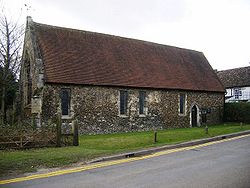 |
A chapel that was once part of the Hospital of St. John at Duxford, in Cambridgeshire, England, the hospital since demolished. Built using flint rubble for the walls and limestone for the doorways and windows. |
| Flag Fen Flag Fen Flag Fen near Peterborough, England is a Bronze Age site, probably religious. It comprises over 60,000 timbers arranged in five very long rows connecting Whittlesey Island with Peterborough across the wet fenland. Part way across the structure, a small island was formed which is where it is... excavations |
Settlement Settlement Settlement may refer to:*Consolidation , a process by which soils decrease in volume*Human settlement, a community where people live**Israeli settlement, communities inhabited by Israeli Jews in territory that came under Israel's control as a result of the 1967 Six-Day War**Urban settlement **Rural... |
Bronze Age Bronze Age The Bronze Age is a period characterized by the use of copper and its alloy bronze as the chief hard materials in the manufacture of some implements and weapons. Chronologically, it stands between the Stone Age and Iron Age... |
Reconstruction | 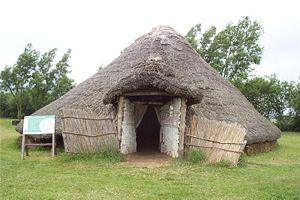 |
A Bronze Age site, probably religious. It comprises over 1,000,000 timbers arranged in five very long rows (around 1 km) connecting Whittlesey Island with Peterborough across the wet fenland. Part way across the structure, a small island was formed which is where it is presumed that the religious ceremonies occurred. The site was first discovered in 1982 when a team led by Francis Pryor carried out a survey of dykes in the area funded by English Heritage. |
| Isleham Priory Church Isleham Priory Church Isleham Priory Church located in Isleham, Cambridgeshire is a Norman church, built in 1090. Despite being converted into a barn, it remains in an unaltered state.St Margaret's was founded in the 11th century... |
Church | 1090 | Complete |  |
A Norman church, Located in Isleham, and part of the former St Margaret's Benedictine Alien Priory. Later converted into a barn, but it remains in an unaltered state. |
| Longthorpe Tower Longthorpe Tower Longthorpe Tower is a fourteenth century, three-storey tower in the care of English Heritage, situated in the village of Longthorpe, now a residential area of Peterborough in the United Kingdom, about two miles to the west of the city centre.... |
Castle Castle A castle is a type of fortified structure built in Europe and the Middle East during the Middle Ages by European nobility. Scholars debate the scope of the word castle, but usually consider it to be the private fortified residence of a lord or noble... |
1310 | Only tower remains | 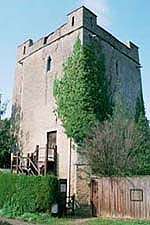 |
A fourteenth century, three-storey tower, originally part of a fortified manor house. Situated in the village of Longthorpe, now a residential area of Peterborough. |
Cheshire
| Name |
Type |
Date |
Condition |
Image | Notes |
|---|---|---|---|---|---|
| Beeston Castle Beeston Castle Beeston Castle is a former Royal castle in Beeston, Cheshire, England , perched on a rocky sandstone crag above the Cheshire Plain. It was built in the 1220s by Ranulf de Blondeville, 6th Earl of Chester, , on his return from the Crusades... |
Castle Castle A castle is a type of fortified structure built in Europe and the Middle East during the Middle Ages by European nobility. Scholars debate the scope of the word castle, but usually consider it to be the private fortified residence of a lord or noble... |
1220 | Ruins | 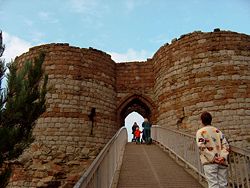 |
A former Royal castle in Beeston, perched on a rocky sandstone crag 110m above the Cheshire Plain. Built by Ranulf de Blondeville, 6th Earl of Chester, on his return from the Crusades. In 1237, Henry III took over the ownership of Beeston, and it was kept in good repair until the 16th century. The castle was slighted in 1646. During the 18th century the site was used as a quarry. |
| Chester Castle Chester Castle Chester Castle is in the city of Chester, Cheshire, England. It is sited at the southwest extremity of the area bounded by the city walls . The castle stands on an eminence overlooking the River Dee. In the castle complex are the remaining parts of the medieval castle together with the... : Agricola Tower and Castle Walls |
Castle Castle A castle is a type of fortified structure built in Europe and the Middle East during the Middle Ages by European nobility. Scholars debate the scope of the word castle, but usually consider it to be the private fortified residence of a lord or noble... |
1070 | Partly complete | 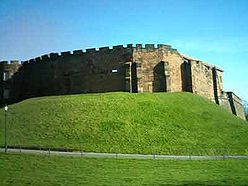 |
The castle stands on an eminence overlooking the River Dee. In the castle complex are the remaining parts of the medieval castle together with the neoclassical buildings designed by Thomas Harrison which were built between 1788 and 1813. Parts of the neoclassical buildings are used today as Crown Courts and as a military museum. The museum and the medieval remains are a tourist attraction. |
| Chester Roman Amphitheatre Chester Roman Amphitheatre Chester Amphitheatre is a Roman amphitheatre in Chester, Cheshire. The site is managed by English Heritage; it has been designated as a Grade I listed building, and a scheduled monument. The ruins currently exposed are those of a large stone amphitheatre, similar to those found in Continental... |
Amphitheatre Amphitheatre An amphitheatre is an open-air venue used for entertainment and performances.There are two similar, but distinct, types of structure for which the word "amphitheatre" is used: Ancient Roman amphitheatres were large central performance spaces surrounded by ascending seating, and were commonly used... |
1st Century | Ruins | 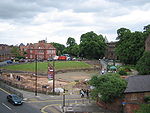 |
Ruins of a large Roman stone amphitheatre, similar to those found in Continental Europe. Today, only the northern half of the structure is exposed; the southern half is covered by buildings. The amphitheatre is the largest so far uncovered in Britain, and dates from the 1st century, when the Roman fort of Deva Victrix was founded. Rediscovered in 1929, when one of the pit walls was discovered during construction work. |
| Sandbach Crosses Sandbach Crosses The Sandbach Crosses are two 9th-century Anglo-Saxon stone crosses now erected in the market place in the town of Sandbach, Cheshire, England. They are unusually large and elaborate examples of the type and have been designated by English Heritage as a Grade I listed building, and are a... |
Monument Monument A monument is a type of structure either explicitly created to commemorate a person or important event or which has become important to a social group as a part of their remembrance of historic times or cultural heritage, or simply as an example of historic architecture... |
9th Century | Complete | 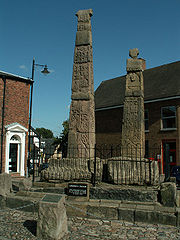 |
Two Anglo-Saxon stone crosses now erected in the market place in the town of Sandbach. They are unusually large and elaborate examples of the type consisting of two upright columns set in sockets on a base of three stepped stones. They depict religious scenes, doll-like heads and beasts in panels, together with vine-scrolls, course interlace patterns and some dragons. |
County Durham
| Name |
Type |
Date |
Condition |
Image | Notes |
|---|---|---|---|---|---|
| Auckland Castle Deer House Auckland Castle Auckland Castle is a castle in the town of Bishop Auckland in County Durham, England.... |
Castle Castle A castle is a type of fortified structure built in Europe and the Middle East during the Middle Ages by European nobility. Scholars debate the scope of the word castle, but usually consider it to be the private fortified residence of a lord or noble... or Mansion Mansion A mansion is a very large dwelling house. U.S. real estate brokers define a mansion as a dwelling of over . A traditional European mansion was defined as a house which contained a ballroom and tens of bedrooms... |
1183 | Complete | Also known as Auckland Palace or locally as the Bishop's Castle or Bishop's Palace, the castle has been the official residence of the Bishop of Durham since 1832. However, it has been owned by the diocese for more than 800 years, being established as a hunting lodge for the Prince Bishops of Durham. It is more like a Gothic country house than a true castle with a military function. The Castle's Scotland Wing presently serves as the administrative offices of the Durham Diocesan Board of Finance. | |
| Barnard Castle Barnard Castle (castle) Barnard Castle is a ruined medieval castle situated in the town of the same name in County Durham. It is a Scheduled Ancient Monument, and was designated as a Grade I listed building in 1950... |
Castle Castle A castle is a type of fortified structure built in Europe and the Middle East during the Middle Ages by European nobility. Scholars debate the scope of the word castle, but usually consider it to be the private fortified residence of a lord or noble... |
1095 | Ruins | 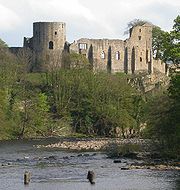 |
A ruined medieval castle originally built on the site of an earlier defended position from around 1095 to 1125 by Guy de Balliol. In the 15th century the castle passed by marriage to the Neville family. Over the next two centuries the Nevilles enlarged and improved the estate and created a substantial and impressive castle. However when Charles Neville, 6th Earl of Westmorland was attainted for his leading role in the Rising of the North, the Neville estates were sequestered. In 1626 the Crown sold the castle and also the Neville property at Raby Castle Raby Castle Raby Castle is situated near Staindrop in County Durham and is one of the largest inhabited castles in England. The Grade I listed building has opulent eighteenth and nineteenth century interiors inside a largely unchanged, late medieval shell. It is the home and seat of John Vane, 11th Baron... to Sir Henry Vane. |
| Bowes Castle Bowes Castle Bowes Castle is in the village of Bowes in County Durham, England . Historically part of the North Riding of Yorkshire.It was built in the corner of an old Roman fort guarding the Stainforth Pass through the Pennines. Around 1136, Alan, Count of Brittany, built a castle in the north-west corner of... |
Castle Castle A castle is a type of fortified structure built in Europe and the Middle East during the Middle Ages by European nobility. Scholars debate the scope of the word castle, but usually consider it to be the private fortified residence of a lord or noble... |
12th Century | Ruins | 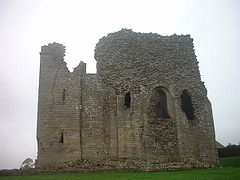 |
Built in the corner of an old Roman fort guarding the Stainforth Pass through the Pennines by Alan, Count of Brittany, in the north-west corner of the site. |
| Derwentcote Steel Furnace Derwentcote Steel Furnace Derwentcote Steel Furnace , Rowlands Gill, near Newcastle, England, built in 1720, is an example of an early cementation furnace which produced high grade steel.It was restored in 1990 by English Heritage.-External links:**... |
Foundry Foundry A foundry is a factory that produces metal castings. Metals are cast into shapes by melting them into a liquid, pouring the metal in a mold, and removing the mold material or casting after the metal has solidified as it cools. The most common metals processed are aluminum and cast iron... |
Complete | 1720 | Located near Rowlands Gill, near Newcastle. It is an example of an early cementation furnace which produced high grade steel. | |
| Egglestone Abbey Egglestone Abbey Egglestone Abbey is an abandoned Premonstratensian Abbey on the eastern bank of the River Tees, 1½ miles south-east of Barnard Castle in County Durham, England, at... |
Abbey Abbey An abbey is a Catholic monastery or convent, under the authority of an Abbot or an Abbess, who serves as the spiritual father or mother of the community.The term can also refer to an establishment which has long ceased to function as an abbey,... |
12th Century | Ruins | An abandoned Abbey on the eastern bank of the River Tees. Founded bywere the Premonstratensians who wore a white habit and became known as the White Canons. They chose the site for the abbey was chosen because of its isolation, close proximity to a river and the supply of local stone for its construction. | |
| Finchale Priory Finchale Priory Finchale Priory was a 13th century Benedictine priory. The remains are sited by the River Wear, four miles from Durham. It is a Grade I listed building.-Current Situation:... |
Priory Priory A priory is a house of men or women under religious vows that is headed by a prior or prioress. Priories may be houses of mendicant friars or religious sisters , or monasteries of monks or nuns .The Benedictines and their offshoots , the Premonstratensians, and the... |
1196 | Ruins | 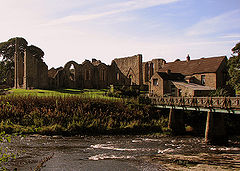 |
A Benedictine priory, sited by the River Wear. Includes the remains of an early 12th century stone chapel of St John the Baptist, the site of Godric of Finchale's burial, built some time around the end of Godric's life. The monastic complex was built in the latter half of the 13th century with alterations and additions continuing for the following three hundred years. |
Cornwall
| Name |
Type |
Date |
Condition |
Image | Notes |
|---|---|---|---|---|---|
| Ballowall Barrow Ballowall Barrow Ballowall Barrow is a prehistoric funerary cairn which Ashbee and Hencken state contains several phases of use from the Neolithic to the Bronze Age. It is situated on the cliff top at Ballowall Common, near St Just in Cornwall, England, UK... |
Cairn Cairn Cairn is a term used mainly in the English-speaking world for a man-made pile of stones. It comes from the or . Cairns are found all over the world in uplands, on moorland, on mountaintops, near waterways and on sea cliffs, and also in barren desert and tundra areas... |
Neolithic Neolithic The Neolithic Age, Era, or Period, or New Stone Age, was a period in the development of human technology, beginning about 9500 BC in some parts of the Middle East, and later in other parts of the world. It is traditionally considered as the last part of the Stone Age... |
Remains | 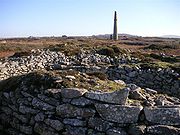 |
A prehistoric funerary cairn (chambered tomb) situated on the cliff top at Ballowall Common, near St Just. Also known as Carn Gluze Barrow. It was first excavated in 1878 by William Copeland Borlase when it was discovered under mining debris. The site today is a confused mix of original and reconstructions introduced by Borlase. The barrow is 22 m in diameter. |
| Carn Euny Ancient Village Carn Euny Carn Euny is an archaeological site near Sancreed, on the Penwith peninsula in Cornwall, United Kingdom with considerable evidence of both Iron Age and post-Iron Age settlement. Excavations on this site have shown that there was activity at Carn Euny as early as the Neolithic period... |
Settlement Settlement Settlement may refer to:*Consolidation , a process by which soils decrease in volume*Human settlement, a community where people live**Israeli settlement, communities inhabited by Israeli Jews in territory that came under Israel's control as a result of the 1967 Six-Day War**Urban settlement **Rural... and Fogou Fogou A fogou or fougou is an underground, dry-stone structure found on Iron Age or Romano-British defended settlement sites in Cornwall. Fogous have similarities with souterrains or earth-houses of northern Europe and particularly Scotland including the Orkney Islands... |
Neolithic Neolithic The Neolithic Age, Era, or Period, or New Stone Age, was a period in the development of human technology, beginning about 9500 BC in some parts of the Middle East, and later in other parts of the world. It is traditionally considered as the last part of the Stone Age... |
Remains | 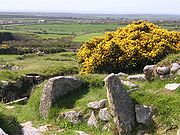 |
An archaeological site near Sancreed, on the Penwith peninsula in Cornwall, with considerable evidence of both Iron Age and post-Iron Age settlement. Carn Euny is best known for the well-preserved state of the large fogou, an underground passageway, which is more than 20m long. |
| Chysauster Ancient Village Chysauster Ancient Village Chysauster Ancient Village is a late Iron Age and Romano-British village of courtyard houses in Cornwall, England, United Kingdom, which is currently in the care of English Heritage... |
Settlement Settlement Settlement may refer to:*Consolidation , a process by which soils decrease in volume*Human settlement, a community where people live**Israeli settlement, communities inhabited by Israeli Jews in territory that came under Israel's control as a result of the 1967 Six-Day War**Urban settlement **Rural... |
Neolithic Neolithic The Neolithic Age, Era, or Period, or New Stone Age, was a period in the development of human technology, beginning about 9500 BC in some parts of the Middle East, and later in other parts of the world. It is traditionally considered as the last part of the Stone Age... |
Remains | 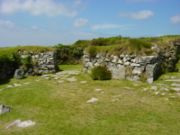 |
A Romano-British village of courtyard houses, believed to have been constructed and occupied between 100 BC and 400 AD; it was primarily agricultural and unfortified and probably occupied by members of the Dumnonii Dumnonii The Dumnonii or Dumnones were a British Celtic tribe who inhabited Dumnonia, the area now known as Devon and Cornwall in the farther parts of the South West peninsula of Britain, from at least the Iron Age up to the early Saxon period... tribe. The village included eight stone dwellings, arranged in pairs along a street, each with its own garden plot. The nearby hill fort of Castle An Dinas may have been a contemporary refuge for the occupants of the village in times of strife. |
| Dupath Well Dupath Well Dupath Well is a nearly intact wellhouse, constructed of local granite, built over a spring. Built of Cornish granite ashlar, it has a steeply-pitched roof, built from courses of granite slabs that run the length of the building. There are badly weathered pinnacles at each corner and a small bell... |
Wellhouse Water well A water well is an excavation or structure created in the ground by digging, driving, boring or drilling to access groundwater in underground aquifers. The well water is drawn by an electric submersible pump, a trash pump, a vertical turbine pump, a handpump or a mechanical pump... |
1510 | Complete | A wellhouse constructed over a local spring. Built of Cornish granite ashlar, it has a steeply-pitched roof, built from courses of granite slabs that run the length of the building. Probably built by the Augustinian canons of the nearby priory of St Germans, to whom the site belonged. | |
| Halliggye Fogou Halliggye Fogou Halliggye Fogou is one of many fogous in Cornwall, England, United Kingdom.The site is under the guardianship of English Heritage, and managed by The Trelowarren Estate... |
Fogou Fogou A fogou or fougou is an underground, dry-stone structure found on Iron Age or Romano-British defended settlement sites in Cornwall. Fogous have similarities with souterrains or earth-houses of northern Europe and particularly Scotland including the Orkney Islands... |
Iron Age Iron Age The Iron Age is the archaeological period generally occurring after the Bronze Age, marked by the prevalent use of iron. The early period of the age is characterized by the widespread use of iron or steel. The adoption of such material coincided with other changes in society, including differing... |
Remains | 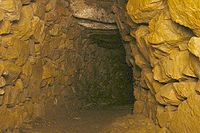 |
Located on the Trelowarren estate near Helston, it consists of a long narrow tunnel leading to three sectioned chambers, and a window-like entrance which was dug in Victorian times by supposed treasure hunters. The complex of passages has a roof and walls of stone, and is the largest and best-preserved of several mysterious underground tunnels associated with Cornish Iron Age settlements. |
| Hurlers Stone Circles The Hurlers (stone circles) The Hurlers are a group of three stone circles in Cornwall, England, UK. The site is half-a-mile west of the village of Minions on the eastern flank of Bodmin Moor, and approximately four miles north of Liskeard at .-Location:The Hurlers are in the Caradon district north of Liskeard in the... |
Stone circle Stone circle A stone circle is a monument of standing stones arranged in a circle. Such monuments have been constructed across the world throughout history for many different reasons.... |
Neolithic Neolithic The Neolithic Age, Era, or Period, or New Stone Age, was a period in the development of human technology, beginning about 9500 BC in some parts of the Middle East, and later in other parts of the world. It is traditionally considered as the last part of the Stone Age... |
Remains |  |
A group of three stone circles. The site is half-a-mile west of the village of Minions on the eastern flank of Bodmin Moor. The circles have diameters of 35m, 42m and 33m. The two outer stone circles are circular, the middle and largest stone circle, however, is slightly elliptical. |
| King Doniert's Stone King Doniert's Stone King Doniert's Stone consists of two pieces of a decorated 9th century cross. The inscription is believed to commemorate Dungarth, King of Cornwall who died around 875.... |
Stone Cross | 9th Century | Remains | 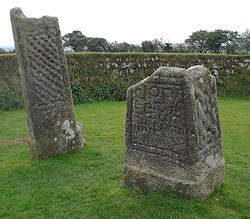 |
Consists of two pieces of a decorated 9th century cross. The inscription is believed to commemorate Dungarth, King of Cornwall who died around 875. The site also includes an underground passage and chamber. |
| Launceston Castle Launceston Castle Launceston Castle is located in the town of Launceston, Cornwall, England, United Kingdom. .-Early history:The castle is a Norman motte and bailey earthwork castle raised by Robert, Count of Mortain, half-brother of William the Conqueror shortly after the Norman conquest, possibly as early as 1067... |
Castle Castle A castle is a type of fortified structure built in Europe and the Middle East during the Middle Ages by European nobility. Scholars debate the scope of the word castle, but usually consider it to be the private fortified residence of a lord or noble... |
11th Century | Ruins | A Norman motte and bailey earthwork castle raised by Robert, Count of Mortain, half-brother of William the Conqueror shortly after the Norman conquest. It became the administrative headquarters for the powerful Earls of Cornwall where they could control the vast estates that they owned throughout the area. The castle remained with little development, apart from an inner keep added in the 12th century. During the 13th century, Richard, Earl of Cornwall, a younger brother of Henry III began to rebuild the castle in stone. | |
| Pendennis Castle Pendennis Castle Pendennis Castle is a Henrician castle, also known as one of Henry VIII's Device Forts, in the English county of Cornwall. It was built in 1539 for King Henry VIII to guard the entrance to the River Fal on its west bank, near Falmouth. St Mawes Castle is its opposite number on the east bank and... |
Device fort Device Forts The Device Forts, also known as Henrician Castles, are a series of artillery fortifications built to defend the southern coast of England by Henry VIII. After his divorce of Catherine of Aragon England was left politically isolated, and the peace of Nice between France and Spain in 1538 aroused... |
1539 | Partly complete | 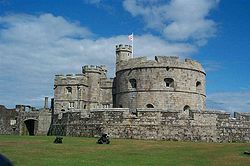 |
A Henrician castle, also known as one of Henry VIII's Device Forts. Built for King Henry VIII to guard the entrance to the River Fal on its west bank, near Falmouth. St Mawes Castle St Mawes Castle St Mawes Castle and its larger sister castle, Pendennis, were built as part of a defensive chain of fortresses by Henry VIII to protect the south coast of Cornwall, England, United Kingdom... is its opposite number on the east bank and they were built to defend Carrick Roads from the French and Spanish threats of future attack. The castle comprises a simple round tower and gate enclosed by a lower curtain wall. |
| Penhallam Penhallam Penhallam is the site of a medieval manor house surrounded by a protective moat. It was designated as a Scheduled Monument in 1996 and is now in the guardianship of English Heritage.... |
Manor House Manor house A manor house is a country house that historically formed the administrative centre of a manor, the lowest unit of territorial organisation in the feudal system in Europe. The term is applied to country houses that belonged to the gentry and other grand stately homes... |
12th Century | Ruins | The site of a former medieval manor house surrounded by a protective moat. Abandoned during the mid-14th century. Penhallam is one of only four such moated medieval manor sites in Cornwall and it consists of a quadrangle of buildings around a central courtyard. The manor was originally reached by a drawbridge over the moat. Later on in the 13th Century a fixed stone bridge was built. | |
| Restormel Castle Restormel Castle Restormel Castle is situated on the River Fowey near Lostwithiel, Cornwall, United Kingdom. It is one of the four chief Norman castles of Cornwall, the others being Launceston, Tintagel and Trematon. The castle is notable for its perfectly circular design... |
Castle Castle A castle is a type of fortified structure built in Europe and the Middle East during the Middle Ages by European nobility. Scholars debate the scope of the word castle, but usually consider it to be the private fortified residence of a lord or noble... |
12th Century | Ruins | 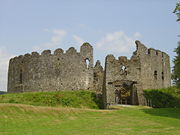 |
Situated on the River Fowey near Lostwithiel, it is one of the four chief Norman castles of Cornwall, the others being Launceston, Tintagel and Trematon. The castle is notable for its perfectly circular design. Although once a luxurious residence to the Earl of Cornwall, the castle became ruined in the years after. |
| St Breock Downs Monolith | Monolith Monolith A monolith is a geological feature such as a mountain, consisting of a single massive stone or rock, or a single piece of rock placed as, or within, a monument... |
Neolithic Neolithic The Neolithic Age, Era, or Period, or New Stone Age, was a period in the development of human technology, beginning about 9500 BC in some parts of the Middle East, and later in other parts of the world. It is traditionally considered as the last part of the Stone Age... |
Remains | A 5m high prehistoric standing stone located near St Breock. | |
| St Catherine's Castle St Catherine's Castle St Catherine's Castle is a small fort commissioned by Henry VIII. It is a two-storey building built to protect Fowey Harbour in Cornwall, United Kingdom. A twin battery of 64-pdr RMLS was added on a lower terrace in 1855... |
Device fort Device Forts The Device Forts, also known as Henrician Castles, are a series of artillery fortifications built to defend the southern coast of England by Henry VIII. After his divorce of Catherine of Aragon England was left politically isolated, and the peace of Nice between France and Spain in 1538 aroused... |
1530's | Remains | A small fort commissioned by Henry VIII. It is a two-storey building built to protect Fowey Harbour. A twin battery of 64-pdr RMLS was added on a lower terrace in 1855. One emplacement was modified in WWII to mount a 4.7" naval gun inside a concrete shelter, but was later removed to restore the Victorian gun races. | |
| St Mawes Castle St Mawes Castle St Mawes Castle and its larger sister castle, Pendennis, were built as part of a defensive chain of fortresses by Henry VIII to protect the south coast of Cornwall, England, United Kingdom... |
Device fort Device Forts The Device Forts, also known as Henrician Castles, are a series of artillery fortifications built to defend the southern coast of England by Henry VIII. After his divorce of Catherine of Aragon England was left politically isolated, and the peace of Nice between France and Spain in 1538 aroused... |
1540's | Remains | 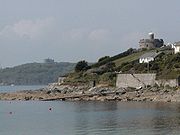 |
St Mawes Castle and its larger sister castle, Pendennis, were built as part of a defensive chain of fortresses by Henry VIII to protect the south coast of Cornwall, England, United Kingdom. This chain of coastal fortifications are known as Henrician Castles or Device Forts |
| Tintagel Castle Tintagel Castle Tintagel Castle is a medieval fortification located on the peninsula of Tintagel Island, adjacent to the village of Tintagel in Cornwall, United Kingdom. The site was possibly occupied in the Romano-British period, due to an array of artefacts dating to this period which have been found on the... |
Castle Castle A castle is a type of fortified structure built in Europe and the Middle East during the Middle Ages by European nobility. Scholars debate the scope of the word castle, but usually consider it to be the private fortified residence of a lord or noble... |
13th Century | Ruins | A medieval fortification located on the peninsula of Tintagel Island. It saw settlement during the Early Medieval period, when it was probably one of the seasonal residences of the regional king of Dumnonia. In the 13th century, during the Later Medieval period, after Cornwall had been subsumed into the kingdom of England, a castle was built on the site by Richard, Earl of Cornwall. | |
| Tregiffian Burial Chamber Tregiffian Burial Chamber The Tregiffian Burial Chamber is a Neolithic or early Bronze age chambered tomb. An entrance passage, lined with stone slabs, leads into a central chamber. It is located near Lamorna in west Cornwall, United Kingdom. It is a rare form of a passage grave, known as an Entrance grave... |
Tomb Tomb A tomb is a repository for the remains of the dead. It is generally any structurally enclosed interment space or burial chamber, of varying sizes... |
Neolithic Neolithic The Neolithic Age, Era, or Period, or New Stone Age, was a period in the development of human technology, beginning about 9500 BC in some parts of the Middle East, and later in other parts of the world. It is traditionally considered as the last part of the Stone Age... |
Remains | A Neolithic or early Bronze age chambered tomb, comprising an entrance passage, lined with stone slabs, leading to a central chamber, located near Lamorna in west Cornwall. | |
| Trethevy Quoit Trethevy Quoit Trethevy Quoit is a well-preserved megalithic tomb located near St Cleer, Cornwall, United Kingdom. It is known locally as "the giant's house". Standing high, it consists of five standing stones capped by a large slab.-Location:... |
Tomb Tomb A tomb is a repository for the remains of the dead. It is generally any structurally enclosed interment space or burial chamber, of varying sizes... |
Neolithic Neolithic The Neolithic Age, Era, or Period, or New Stone Age, was a period in the development of human technology, beginning about 9500 BC in some parts of the Middle East, and later in other parts of the world. It is traditionally considered as the last part of the Stone Age... |
Remains |  |
A well-preserved megalithic tomb located near St Cleer. It is known locally as "the giant's house" and stands 2.7m high, and consists of five standing stones capped by a large slab. |
Cumbria
- Ambleside Roman Fort
- Bow BridgeBow Bridge, CumbriaBow Bridge is a late medieval bridge located near Furness Abbey in Cumbria. It is made of stone and crosses Mill Beck. It has been a Grade II Listed Structure since 1993....
- Brough CastleBrough CastleBrough Castle is a ruined castle in the village of Brough, Cumbria , England. It is currently administered by English Heritage. The Castle consists of a large mound, on which there is an extensive range of buildings, with a circular corner tower, and the remnants of an older four storey...
- Brougham CastleBrougham CastleBrougham Castle is a medieval building about south-east of Penrith, Cumbria, England. It is a Scheduled Monument and open to the public. Founded by Robert de Vieuxpont in the early 13th century on the site of a Roman fort, it sits near the confluence of the rivers Eamont and Lowther...
- Carlisle CastleCarlisle CastleCarlisle Castle is situated in Carlisle, in the English county of Cumbria, near the ruins of Hadrian's Wall. The castle is over 900 years old and has been the scene of many historical episodes in British history. Given the proximity of Carlisle to the border between England and Scotland, it...
- Castlerigg Stone CircleCastlerigg stone circleThe stone circle at Castlerigg is situated near Keswick in Cumbria, North West England...
- Clifton HallClifton Hall, CumbriaClifton Hall in the civil parish of Clifton, Cumbria, England, was a 15th century fortified manor house which was home to the Clifton family for almost 600 years...
- Countess PillarCountess PillarThe Countess Pillar is a 17th-century monument near Brougham, Cumbria, England, between Penrith and Appleby. It is two miles east of Penrith on the A66...
- Furness AbbeyFurness AbbeyFurness Abbey, or St. Mary of Furness is a former monastery situated on the outskirts of the English town of Barrow-in-Furness, Cumbria. The abbey dates back to 1123 and was once the second wealthiest and most powerful Cistercian monastery in the country, behind only Fountains Abbey in North...
- Hadrian's WallHadrian's WallHadrian's Wall was a defensive fortification in Roman Britain. Begun in AD 122, during the rule of emperor Hadrian, it was the first of two fortifications built across Great Britain, the second being the Antonine Wall, lesser known of the two because its physical remains are less evident today.The...
- Banks East Turret
- Birdoswald Roman Fort
- Hare Hill
- Harrows Scar Milecastle and Wall
- King's Stables (Milecastle 48)
- Leahill Turret and Piper Sike Turret
- Pike Hill Signal Tower
- Willowford Wall, Turrets and Bridge
- Hardknott Roman FortHardknott Roman FortMediobogdum was a fort in the Roman province of Britannia. Its remains are located on the western side of the Hardknott Pass in the English county of Cumbria .-The location and name:...
- King Arthur's Round TableKing Arthur's Round Table, CumbriaKing Arthur's Round Table is a Neolithic henge in the village of Eamont Bridge within the English county of Cumbria, around 2 km south east of Penrith. The site is free to visitors and is under the control of English Heritage....
- Lanercost PrioryLanercost PrioryLanercost Priory was founded by Robert de Vaux between 1165 and 1174, the most likely date being 1169, to house Augustinian Canons. It is situated at the village of Lanercost, Cumbria, England, within sight of Naworth Castle, with which it long had close connections.It is now open to the public and...
- Mayburgh HengeMayburgh HengeMayburgh Henge is a large prehistoric monument in the county of Cumbria in northern England. Mayburgh Henge is just outside the village of Eamont Bridge close to the confluence of the Rivers Eamont and Lowther around 1 mile south of Penrith, just a few hundred yards from the M6 motorway.Mayburgh...
- Penrith CastlePenrith CastlePenrith Castle was built between 1399 and 1470 as a defense against Scottish raids. It is believed to have been first built by William Strickland who later become Bishop of Carlisle...
- Piel CastlePiel CastlePiel Castle also known as Fouldry Castle, is a castle situated on the south-eastern point of Piel Island, 1 km off the southern tip of the Furness Peninsula, protecting the deep water harbour of Barrow-in-Furness in north west England.....
- Ravenglass Roman Bath HouseRavenglass Roman Bath HouseRavenglass Roman Bath House is one of a few surviving structures from a 2nd century Roman fort and naval base. Described by Matthew Hyde in his update to the Pevsner Guide to Cumbria as "an astonishing survival", the still standing walls are 13 ft high...
- Shap AbbeyShap AbbeyShap Abbey was a monastic religious house of the Premonstratensian order on the western bank of the River Lowther in the civil parish of Shap Rural, around from the village of Shap, in the Eden District of Cumbria, England...
- Stott Park Bobbin MillStott Park Bobbin MillStott Park Bobbin Mill was built in 1835 by John Harrison. Located near Newby Bridge, Cumbria, England, it provided the wooden bobbins to the Lancashire weaving and spinning industry, up to a quarter of a million bobbins per week. The mill was originally powered by a water wheel drawing the water...
- Wetheral Priory GatehouseWetheral Priory GatehouseWetheral Priory Gatehouse is almost all that remains of the Benedictine Wetheral Priory in Wetheral, Cumbria. Wetheral Priory, was founded in 1106 from its motherhouse of St. Mary's Abbey, York. The gatehouse is virtually the only standing remnant of the much grander Priory buildings, and was the...
Derbyshire
- Arbor Low Stone CircleArbor LowArbor Low is a Neolithic henge monument in the Peak District, Derbyshire, England. Arbor Low is located in the White Peak zone of the Peak District in Derbyshire . The White Peak is a Carboniferous Limestone plateau lying between approximately 200-400m OD...
and Gib Hill Barrow - Bolsover CastleBolsover CastleBolsover Castle is a castle in Bolsover, Derbyshire, England .-History:It was built by the Peverel family in the 12th century and became Crown property in 1155 when the third William Peverel fled into exile...
- Bolsover Cundy HouseBolsover Cundy HouseBolsover Cundy House is a recently restored 17th century conduit house that was used to supply water to the nearby Bolsover Castle. It is located near Houfton Road in Bolsover....
- Hardwick Old Hall
- Hob Hurst's HouseHob Hurst's HouseHob Hurst's House is a Bronze Age barrow, located in Derbyshire, near the town of Bakewell. It is unique in that instead of the normal round shape, Hob Hurst's barrow is rectangular...
- Nine Ladies Stone CircleNine LadiesNine Ladies is a Bronze Age stone circle located on Stanton Moor, Derbyshire, England. Part of the Peak District National Park, the site is owned by English Heritage and is often visited by tourists and hill walkers...
- Peveril CastlePeveril CastlePeveril Castle is a medieval building overlooking the village of Castleton in the English county of Derbyshire. Its site provides views across the Hope Valley and Cave Dale. The castle is named after its founder, William Peveril, who held lands in Nottinghamshire and Derbyshire on behalf of the king...
- Sutton Scarsdale HallSutton Scarsdale HallSutton Scarsdale Hall is a Grade 1 listed Georgian ruined stately home in Sutton Scarsdale, just outside Chesterfield, Derbyshire.-Estate history:...
- Wingfield ManorWingfield ManorWingfield Manor is a deserted and ruined manor house some 4 miles from the town of Alfreton in the English county of Derbyshire...
Devon
- Bayard's Cove FortBayard's Cove FortBayard's Cover Fort is a small early Tudor artillery fort, built to defend the harbour entrance at Dartmouth, Devon, England.The tower was a third means of defence for the port, providing additional fire to protect the port should any enemy ships have broken past Dartmouth Castle and Kingswear...
- Berry Pomeroy CastleBerry Pomeroy CastleBerry Pomeroy Castle, a Tudor mansion within the walls of an earlier castle, is near the village of Berry Pomeroy, in South Devon, England. It was built in the late 15th century by the Pomeroy family which had held the land since the 11th century. By 1547 the family was in financial difficulties...
- Blackbury CampBlackbury CampBlackbury Camp is an Iron Age hill fort situated near Seaton, Devon, England. The ramparts are still relatively high, showing an unusual entrance feature. The fort occupies the end of a large ridge at some above sea level. It was defended by a single bank and ditch, forming a roughly D-shaped...
- Dartmouth CastleDartmouth CastleDartmouth Castle is one of a pair of forts, the other being Kingswear Castle, that guard the mouth of the Dart Estuary in Devon, England .A small fortalice was built in 1388 under the direction of John Hawley...
- GrimspoundGrimspoundGrimspound is a late Bronze Age settlement, situated on Dartmoor in Devon, England. It consists of a set of 24 hut circles surrounded by a low stone wall...
- Hound Tor Deserted Medieval VillageHound TorHound Tor is a tor on Dartmoor, Devon, England and is a good example of a heavily weathered granite outcrop. It is easily accessible, situated within a few minutes from the B3387 between Bovey Tracey and Widecombe-in-the-Moor...
- Kirkham HouseKirkham House__FORCETOC__ thumb|250px|The dining room at Kirkham HouseKirkham House is a late medieval stone house in Paignton, Devon, England.-History:It is not known when Kirkham House was built, although the design suggests that it is of 14th or 15th century origin...
- Lydford Castle and Saxon TownLydfordLydford, sometimes spelled Lidford, is a village, once an important town, in Devon situated north of Tavistock on the western fringe of Dartmoor in the West Devon district.-Description:The village has a population of 458....
- Merrivale Prehistoric SettlementMerrivale, DevonMerrivale is a locality in western Dartmoor, in the West Devon district of Devon, England. It is best known for the nearby series of Bronze Age megalithic monuments to the south and a former granite quarry.-Merrivale hamlet:...
- Okehampton CastleOkehampton CastleOkehampton Castle is a ruined motte and bailey castle situated in Devon, England.The castle has Norman origins and dates from the late 11th century...
- Royal Citadel, PlymouthRoyal Citadel, PlymouthThe Royal Citadel in Plymouth, Devon, England, was built in the late 1660s to the design of Sir Bernard de Gomme. It is at the eastern end of Plymouth Hoe overlooking Plymouth Sound, and encompasses the site of the earlier fort that had been built in the time of Sir Francis Drake.During the Dutch...
- Totnes CastleTotnes CastleTotnes Castle is one of the best preserved examples of a Norman motte and bailey castle in England. It is situated in the town of Totnes on the River Dart in Devon...
- Upper Plym ValleyUpper Plym ValleyThe Upper Plym Valley is an area of Dartmoor, Devon, England, particularly noted for a large array of archaeological sites rnging from prehistoric Drizzlecombe to 19th century Eylesbarrow Mine...
Dorset
- Abbotsbury AbbeyAbbotsbury AbbeyThe Abbey of St Peter was a Benedictine monastery in the village of Abbotsbury in Dorset, England. The abbey was founded in the eleventh century by King Cnut's thegn Orc and his wife Tola, who handsomely endowed the monastery with lands in the area. The abbey prospered and became a local centre of...
- Christchurch CastleChristchurch CastleChristchurch Castle is located in Christchurch, Dorset, England . The earliest stonework has been dated to 1160 AD. It is a Norman motte and bailey castle...
& Norman House - Fiddleford ManorFiddleford ManorFiddleford Manor is a medieval manor house located near Sturminster Newton, Dorset, England. Originally built for the sheriff of Dorset, it is still a complete building with 600-year-old complex wooden roofs and is currently open to the public year-round....
- Jordan Hill Roman TempleJordan Hill Roman TempleJordan Hill Roman Temple is a Roman ruin situated on Jordan Hill above Bowleaze Cove in the eastern suburbs of Weymouth in Dorset, England. ....
- Kingston Russell Stone Circle
- Knowlton Church and Earthworks
- Lulworth CastleLulworth CastleLulworth Castle, in East Lulworth, Dorset, situated south of Wool, is an early 17th century mock castle. The stone building has now been re-built as a museum....
- Maiden CastleMaiden Castle, DorsetMaiden Castle is an Iron Age hill fort south west of Dorchester, in the English county of Dorset. Hill forts were fortified hill-top settlements constructed across Britain during the Iron Age...
- The Nine Stones
- Portland CastlePortland CastlePortland Castle is one of the Device Forts, also known as Henrician Castles, built in 1539 by Henry VIII on the Isle of Portland to guard the natural Portland anchorage known as the Portland Roads. The castle lies in the far north of the island, in the village now called Castletown, near Fortuneswell...
- St Catherine's Chapel
- Sherborne Old CastleSherborne CastleSherborne Castle is a 16th-century Tudor mansion southeast of Sherborne in Dorset, England. The park formed only a small part of the Digby estate.-Old castle:Sherborne Old Castle is the ruin of a 12th-century castle in the grounds of the mansion...
- Winterbourne Poor Lot Barrows
Durham
- Auckland Castle Deer House
- Barnard Castle (castle)Barnard Castle (castle)Barnard Castle is a ruined medieval castle situated in the town of the same name in County Durham. It is a Scheduled Ancient Monument, and was designated as a Grade I listed building in 1950...
- Bowes CastleBowes CastleBowes Castle is in the village of Bowes in County Durham, England . Historically part of the North Riding of Yorkshire.It was built in the corner of an old Roman fort guarding the Stainforth Pass through the Pennines. Around 1136, Alan, Count of Brittany, built a castle in the north-west corner of...
- Derwentcote Steel FurnaceDerwentcote Steel FurnaceDerwentcote Steel Furnace , Rowlands Gill, near Newcastle, England, built in 1720, is an example of an early cementation furnace which produced high grade steel.It was restored in 1990 by English Heritage.-External links:**...
- Egglestone AbbeyEgglestone AbbeyEgglestone Abbey is an abandoned Premonstratensian Abbey on the eastern bank of the River Tees, 1½ miles south-east of Barnard Castle in County Durham, England, at...
- Finchale PrioryFinchale PrioryFinchale Priory was a 13th century Benedictine priory. The remains are sited by the River Wear, four miles from Durham. It is a Grade I listed building.-Current Situation:...
East Sussex
- Battle AbbeyBattle AbbeyBattle Abbey is a partially ruined abbey complex in the small town of Battle in East Sussex, England. The abbey was built on the scene of the Battle of Hastings and dedicated to St...
- Battle of Hastings BattlefieldBattle of HastingsThe Battle of Hastings occurred on 14 October 1066 during the Norman conquest of England, between the Norman-French army of Duke William II of Normandy and the English army under King Harold II...
- Camber CastleCamber CastleCamber Castle is one of Henry VIII's Device Forts, also known as Henrician Castles, built to protect the huge Rye anchorage .It is approximately 2 km south of Rye and 2 km northeast of Winchelsea....
- Pevensey CastlePevensey CastlePevensey Castle is a medieval castle and former Roman fort at Pevensey in the English county of East Sussex. The site is a Scheduled Monument in the care of English Heritage and is open to visitors.-Roman fort:...
Essex
- Audley End HouseAudley End HouseAudley End House is largely an early 17th-century country house just outside Saffron Walden, Essex, south of Cambridge, England. It was once a palace in all but name and renowned as one of the finest Jacobean houses in England. Audley End is now only one-third of its original size, but is still...
- Hadleigh CastleHadleigh CastleHadleigh Castle in the English county of Essex overlooks the Thames estuary from a ridge to the south of the town of Hadleigh. Built after 1215 during the reign of Henry III by Hubert de Burgh, the castle was surrounded by parkland and had an important economic, as well as defensive role...
- Hill Hall
- Lexden Earthworks and Bluebottle Grove
- Mistley TowersMistley TowersMistley Towers are the twin towers of the now demolished Church of St. Mary the Virgin at Mistley in Essex. The original Georgian parish church on the site had been built in classical style early in the 18th century following the death of Richard Rigby Esquire...
- Prior's Hall Barn
- St. Botolph's PriorySt. Botolph's PriorySt Botolph's Priory, located in Colchester, England, was the first English Augustinian priory church, founded at the end of the eleventh century from the Anglo-Saxon minster community of Colchester. Only the ruined remains of the nave survive today, under the care of English Heritage...
- St John's Abbey Gate, Colchester
- Tilbury Fort
- Waltham Abbey Gatehouse and BridgeWaltham Abbey (abbey)The Abbey Church of Waltham Abbey has been a place of worship since at least 1030, and is in the town of Waltham Abbey, Essex, England. The Prime Meridian passes through its grounds. Harold Godwinson is said to be buried just outside the present abbey...
Gloucestershire
- Belas Knap Long BurrowBelas KnapBelas Knap is a neolithic chambered long barrow, situated on Cleeve Hill, near Cheltenham and Winchcombe, in Gloucestershire, England. It is a scheduled ancient monument in the care of English Heritage but managed by Gloucestershire County Council. "Belas" is possibly derived from the Latin word...
- BlackfriarsBlackfriars, GloucesterBlackfriars in the town of Gloucester, Gloucestershire, England is a surviving friary of the Dominican Order. The friary went into private hands after the Dissolution of the Monasteries, having been acquired in 1539 by Thomas Bell , who used the church as his residence, known as "Bell Place", and...
- Cirencester AmphitheatreQuerns area, CirencesterThe Querns is an area of Cirencester, an ancient market town in the Cotswold hills of England.Its principle feature is the town's famous Roman amphitheatre, an impressive ancient monument that is surrounded by many other archaeological features, most notably the extensive Roman Quarries and a huge...
- Great Witcombe Roman VillaGreat Witcombe Roman VillaGreat Witcombe Roman Villa was a villa built during the Roman occupation of Britain. It is located on a hillside at Great Witcombe, near Gloucester in the English county of Gloucestershire.-Background:...
- GreyfriarsGloucesterGloucester is a city, district and county town of Gloucestershire in the South West region of England. Gloucester lies close to the Welsh border, and on the River Severn, approximately north-east of Bristol, and south-southwest of Birmingham....
- Hailes AbbeyHailes AbbeyHailes Abbey is two miles northeast of Winchcombe, Gloucestershire, England.The abbey was founded in 1245 or 1246 by Richard, Earl of Cornwall, called "King of the Romans" and the younger brother of King Henry III of England. He was granted the manor of Hailes by Henry, and settled it with...
- Kingswood Abbey GatehouseKingswood AbbeyKingswood Abbey was a Cistercian abbey, located in the village of Kingswood near Wotton-under-Edge, Gloucestershire, England.- History :Kingswood Abbey was founded in the year 1169 by William of Berkeley in accordance with the wishes of his uncle, Roger II of Berkeley, and colonised from the...
- Notgrove Long BarrowNotgrove Long BarrowNotgrove Long Barrow is a prehistoric long barrow burial mound in Gloucestershire, England.It consists of a large mound with a passage running through the centre and several small chambers opening off it. Human remains were interred in these chambers...
- Nympsfield Long BarrowNympsfield Long BarrowNympsfield Long Barrow is the remains of a Neolithic burial site or barrow, located close to the village of Nympsfield in Gloucestershire, South West England....
- Odda's ChapelOdda's ChapelOdda's Chapel is a surviving Saxon church at Deerhurst, Gloucestershire. Earl Odda had it built for the benefit of the soul of his brother Aelfric, who died on 22 December 1053. Bishop Ealdred consecrated it: an inscription dates the dedication to 12 April 1056...
- Offa's DykeOffa's DykeOffa's Dyke is a massive linear earthwork, roughly followed by some of the current border between England and Wales. In places, it is up to wide and high. In the 8th century it formed some kind of delineation between the Anglian kingdom of Mercia and the Welsh kingdom of Powys...
- Over BridgeOver BridgeOver Bridge is a single span stone arch bridge spanning the canalised West Channel of the River Severn near Gloucester. It links Over to Alney Island....
- St Briavel's CastleSt Briavel's CastleSt Briavels Castle is a moated Norman castle at St Briavels in the English county of Gloucestershire. The castle is noted for its huge Edwardian gatehouse that guards the entrance....
- St Mary's ChurchKempleyKempley is a village in the Forest of Dean district of Gloucestershire, England, close to the border with Herefordshire.The small village has two notable churches, one dedicated to St Mary and another to St Edward the Confessor.St...
- Uley BuryUley Buryright|thumb|500px|View along the north-eastern rampart of Uley Bury, drawn by E.J. Burrow in 1913Uley Bury is the long, flat-topped hill just outside Uley, Gloucestershire, England. It is an impressive multi-vallate, scarp-edge Iron Age hill fort dating from around 300 B.C...
- Uley Long BarrowUley Long BarrowUley Long Barrow, also known locally as "Hetty Pegler's Tump", is a Neolithic burial mound, near the village of Uley, Gloucestershire, England. Although typically described as a long barrow, the mound is actually a transected gallery grave...
(Hetty Pegler's Tump) - Windmill Tump Long Barrow
Hampshire
- Bishop's Waltham PalaceBishop's Waltham PalaceBishop's Waltham Palace is a moated Bishop's Palace ruin in Bishop's Waltham, Hampshire, England. It is a scheduled ancient monument.It was built by Henry de Blois in 1135....
- Calshot CastleCalshot CastleCalshot Castle is one of Henry VIII's device forts, built on Calshot Spit at the Solent near Fawley to guard the entrance to Southampton Water...
- Flowerdown BarrowsFlowerdown BarrowsFlowerdown Barrows is an English Heritage Barrow site near Littleton, Winchester, Hampshire, England.The site has three Bronze Age burial mounds in a much larger cemetery, including a well-preserved disc barrow which has been described as "the finest in Hampshire".-External links:*.* site page on...
- Fort BrockhurstFort BrockhurstFort Brockhurst is one of the Palmerston Forts, in Gosport, England. It is now an English Heritage property.Fort Brockhurst was designed by William Crossman in the 19th century to protect Portsmouth...
- Fort CumberlandFort Cumberland (England)Fort Cumberland is a pentagonal artillery fortification erected to guard the entrance to Langstone Harbour, east of the naval port of Portsmouth on the south coast of England. It was sited to protect the Royal Navy Dockyard, by preventing enemy forces from landing in Langstone Harbour and attacking...
- Hurst CastleHurst CastleHurst Castle on the south coast of England is one of Henry VIII's Device Forts, built at the end of a long shingle barrier beach at the west end of the Solent to guard the approaches to Southampton. Hurst Castle was sited at the narrow entrance to the Solent where the ebb and flow of the tides...
- Itchen Abbas Roman VillaItchen AbbasItchen Abbas is a village on the River Itchen about north-east of Winchester in Hampshire, England. The village is part of the Itchen Valley civil parish.A major oil pipeline from Hamble to Aldermaston runs through Itchen Abbas.-Parish church:...
- King James's and Landport GatesKing James's and Landport GatesKing James's and Landport Gates are two English Heritage sites in Portsmouth, Hampshire, England.The ornate gateways were originally access points to Portsmouth through the town walls...
, PortsmouthPortsmouthPortsmouth is the second largest city in the ceremonial county of Hampshire on the south coast of England. Portsmouth is notable for being the United Kingdom's only island city; it is located mainly on Portsea Island... - Medieval Merchant's HouseMedieval Merchant's HouseThe Medieval Merchant's House is a restored late 13th-century building in Southampton, Hampshire, England. Built in about 1290 by John Fortin, a prosperous merchant, the house survived many centuries of domestic and commercial use largely intact...
, SouthamptonSouthamptonSouthampton is the largest city in the county of Hampshire on the south coast of England, and is situated south-west of London and north-west of Portsmouth. Southampton is a major port and the closest city to the New Forest... - Netley AbbeyNetley AbbeyNetley Abbey is a ruined late medieval monastery in the village of Netley near Southampton in Hampshire, England. The abbey was founded in 1239 as a house for Roman Catholic monks of the austere Cistercian order. Despite being a royal abbey, Netley was never rich, produced no influential scholars...
- Northington GrangeNorthington GrangeNorthington Grange is a mansion near New Alresford, Hampshire, England. It is owned by Lord Ashburton's family and is under the guardianship of English Heritage. The exterior of the building is open to the public and the village of Northington is nearby...
- Portchester CastlePortchester CastlePortchester Castle is a medieval castle built within a former Roman fort at Portchester to the east of Fareham in the English county of Hampshire. Probably founded in the late 11th century, Portchester was a baronial castle that was taken under royal control in 1154. The monarchy controlled...
- Royal Garrison Church (Domus Dei), PortsmouthPortsmouthPortsmouth is the second largest city in the ceremonial county of Hampshire on the south coast of England. Portsmouth is notable for being the United Kingdom's only island city; it is located mainly on Portsea Island...
- Silchester Roman City Walls and Amphitheatre
- Southwick PriorySouthwick PriorySouthwick Priory was a priory of Augustinian canons originally founded in Portchester Castle and later transferred to Southwick, Hampshire, England.-Foundation:...
- Titchfield AbbeyTitchfield AbbeyTitchfield Abbey is a medieval abbey and later country house, located in the village of Titchfield near Fareham in Hampshire, England. The abbey was founded in 1222 for Premonstratensian canons, an austere order of priests...
- Wolvesey CastleWolvesey CastleWolvesey Castle is a ruined castle in Winchester, Hampshire, England. It was erected by the Bishop of Winchester Henry of Blois between 1130 and 1140....
(Old Bishop's Palace), WinchesterWinchesterWinchester is a historic cathedral city and former capital city of England. It is the county town of Hampshire, in South East England. The city lies at the heart of the wider City of Winchester, a local government district, and is located at the western end of the South Downs, along the course of...
Herefordshire
- Arthur's StoneArthur's Stone, HerefordshireArthur's Stone, Herefordshire is a Neolithic chambered tomb, or Dolmen, dating from 3,700 BC – 2,700 BC and is situated on the ridge line of a hill overlooking both the Golden Valley, Herefordshire and the Wye Valley, Herefordshire.- Location :...
- Edvin Loach Old ChurchEdvin LoachEdvin Loach, also Edwin Loach, is a village in eastern Herefordshire, England, about four miles north of the town of Bromyard, and near the village of Edwin Ralph...
- Goodrich CastleGoodrich, HerefordshireGoodrich is a village, in south Herefordshire, England which is very close to Gloucestershire and the Forest of Dean situated near the River Wye at and is famous for its old red sandstone Norman and medieval castle.Not strictly in the Forest of Dean but close enough to count Goodrich is a small...
- Longtown CastleLongtown CastleLongtown Castle is a ruin, originally a Norman Motte and Bailey castle and later stone castle built to provide defence against the Welsh and protect the border of Herefordshire.- Location :It is located in Longtown, Herefordshire....
- Mortimer's Cross Water MillMortimer's Cross Water MillMortimer's Cross Water Mill is an 18th century watermill located on the River Lugg, northwest of Leominster, Herefordshire, England. It is owned by English Heritage and is in partial working order.-External links:* *...
- Rotherwas ChapelRotherwas ChapelRotherwas Chapel is a family chapel, once belonging to the Bodenham family. It is now state-owned and administered by English Heritage. The chapel contains structures from medieval, Elizabethan, Georgian and Victorian periods...
- Wigmore CastleWigmore CastleWigmore Castle is a ruined castle which is barely visible from the village of Wigmore in the northwest region of Herefordshire, England.- History :...
Hertfordshire
- Berkhamsted CastleBerkhamsted CastleBerkhamsted Castle is a ruined Norman motte-and-bailey castle at Berkhamsted in Hertfordshire, England.The original fortification dates from Saxon times. Work on the Norman structure was started in 1066 by William the Conqueror who later passed the castle to his half-brother, Robert, Count of...
- Old Gorhambury HouseOld Gorhambury HouseOld Gorhambury House located near St Albans, Hertfordshire, England is an Elizabethan mansion, built in 1563-8 by Sir Nicholas Bacon, Lord Keeper, and visited a number of times by Queen Elizabeth....
- St Albans Roman WallVerulamiumVerulamium was an ancient town in Roman Britain. It was sited in the southwest of the modern city of St Albans in Hertfordshire, Great Britain. A large portion of the Roman city remains unexcavated, being now park and agricultural land, though much has been built upon...
Isle of Wight
- Appuldurcombe HouseAppuldurcombe HouseAppuldurcombe House is the shell of a large 18th-century baroque country house of the Worsley family. The house is situated near to Wroxall on the Isle of Wight....
- Carisbrooke CastleCarisbrooke CastleCarisbrooke Castle is a historic motte-and-bailey castle located in the village of Carisbrooke, near Newport, Isle of Wight, England. Charles I was imprisoned at the castle in the months prior to his trial.-Early history:...
- Osbourne House
- St Catherine's OratorySt Catherine's OratorySt. Catherine's Oratory is a medieval lighthouse on St. Catherine's Down near the southern coast of the Isle of Wight, the Back of the Wight. It was built by Lord of Chale Walter de Godeton as an act of penance for plundering wine from the wreck of St. Marie of Bayonne in Chale Bay on April 20,...
- Yarmouth CastleYarmouth CastleYarmouth Castle is a small off-square blockhouse built by Henry VIII in 1547, to guard Yarmouth harbour on the Isle of Wight. It was built as part of Henry's second device programme to fortify the English coast with a chain of coastal defences known as Device Forts or Henrician Castles. These were...
Isles of Scilly
- Bant's Carn Burial ChamberBant's CarnBant's Carn is a Scillonian entrance grave on the island of St Mary's in the Isles of Scilly. A military battery built in 1905 also stands nearby....
- Cromwell's Castle
- Garrison WallsSt. Mary's, Isles of ScillySt Mary's is the largest island of the Isles of Scilly, an archipelago off the southwest coast of Cornwall in the United Kingdom.-Description:...
- Halangy Down Ancient VillageBant's CarnBant's Carn is a Scillonian entrance grave on the island of St Mary's in the Isles of Scilly. A military battery built in 1905 also stands nearby....
- Harry's WallsSt. Mary's, Isles of ScillySt Mary's is the largest island of the Isles of Scilly, an archipelago off the southwest coast of Cornwall in the United Kingdom.-Description:...
- Innisidgen Lower and Upper Burial ChambersScillonian entrance graveThe entrance graves of Cornwall and the Isles of Scilly, and south east Ireland are megalithic chamber tombs of the Neolithic and early Bronze Age in the British Isles. Comparable sites are also known in Brittany and the Channel Islands...
- Kings Charles's Castle
- Old Blockhouse
- Porth Hellick Down Burial ChamberPorth Hellick DownPorth Hellick Down is an area of downland on the east side of the island of St Mary's in the Isles of Scilly.Seven Scillonian entrance graves stand on the down in a general state of decay. The largest is the Great Tomb which has a 12m diameter and a central burial chamber 3m long and 1m high. An...
Kent
- Bayham Old AbbeyBayham Old AbbeyBayham Old Abbey is an English Heritage property, located near Frant, East Sussex, England. Founded c. 1207 through a combination of the failing Premonstratensian monasteries of Otham and Brockley, Bayham functioned as an abbey until its dissolution in the 16th century...
- Deal CastleDeal CastleDeal Castle is located in Deal, Kent, England, between Walmer Castle and the now lost Sandown Castle .-Construction:It is one of the most impressive of the Device Forts or Henrician Castles built by Henry VIII between 1539 and 1540 as an artillery fortress to counter the threat of invasion from...
- DengeDengeDenge is a former Royal Air Force site near Dungeness, in Kent, England. It is best known for the early experimental acoustic mirrors which remain there....
Acoustic Mirrors - Down HouseDown HouseDown House is the former home of the English naturalist Charles Darwin and his family. It was in this house and garden that Darwin worked on his theories of evolution by natural selection which he had conceived in London before moving to Downe....
(Home of Charles Darwin) - Dover CastleDover CastleDover Castle is a medieval castle in the town of the same name in the English county of Kent. It was founded in the 12th century and has been described as the "Key to England" due to its defensive significance throughout history...
, Western Heights and Knights Templar Church - DymchurchDymchurchDymchurch is a village and civil parish in the Shepway District of Kent, England. The village is located on the coast five miles south-west of Hythe, and on the Romney Marsh. It is typical of this part of the coast, having been a village which became larger during the 1930s...
Martello Tower - Eynsford CastleEynsford CastleEynsford Castle is one of the most complete Norman castles in England, located close to the village of Eynsford. Built in 1088, ransacked in the 14th century it fell into decay and is now in the care of English Heritage and open to the public...
- Faversham Stone ChapelFaversham Stone ChapelFaversham Stone Chapel refers to the ruined Church of Our Lady of Elwarton, located near Faversham, Kent, England. Its origins date back to the Roman era when it was used for pagan purposes. In AD 601 Pope Gregory directed St.Augustine not to destroy pagan buildings, but to adapt them for Christian...
- Horne's Place Chapel
- Kit's Coty HouseKit's Coty HouseKit's Coty House or Kit's Coty is the name of the remains of a Neolithic chambered long barrow on Blue Bell Hill near Aylesford in the English county of Kent. It is one of the Medway megaliths....
- Knights Templar Church
- Little Kit's Coty HouseCountless StonesThe Countless Stones, also known as Little Kit's Coty House, is the name of the remains of a Neolithic chambered long barrow on Blue Bell Hill near Aylesford in the English county of Kent. The site is one of the Medway megaliths...
- Lullingstone Roman villaLullingstone Roman villaLullingstone Roman Villa is a villa built during the Roman occupation of Britain, situated near the village of Eynsford in Kent, south eastern England....
- Maison DieuMaison Dieu, FavershamMaison Dieu is a hospital, monastery, hostel, retirement home and Royal lodge commissioned by Henry III in 1234.The building is located beside what is now the A2 road in Faversham, Kent. It is owned by English Heritage and managed by the Faversham Society...
- Milton ChantryGravesend, KentGravesend is a town in northwest Kent, England, on the south bank of the Thames, opposite Tilbury in Essex. It is the administrative town of the Borough of Gravesham and, because of its geographical position, has always had an important role to play in the history and communications of this part of...
- Mote ParkMote ParkMote Park is a 180 hectare multi-use public park in Maidstone, Kent. Previously a country estate it was converted to landscaped park land at the end of the 18th century before becoming a municipal park. It includes the former stately home Mote House together with a miniature railway, pitch and putt...
- Old Soar ManorOld Soar ManorOld Soar Manor is an English Heritage property, owned and maintained by the National Trust. Located near Plaxtol, Kent, England, it is a small 13th century stone manor house.- External links :**...
- Reculver Towers and Roman FortReculverReculver is a hamlet and coastal resort situated about east of Herne Bay in southeast England. It is a ward of the City of Canterbury district in the county of Kent. Reculver once occupied a strategic location at the western end of the Wantsum Channel, between the Isle of Thanet and the Kent...
- Richborough Roman FortRutupiaeRichborough Castle contains the ruined remains of a Roman Saxon Shore Fort. It situated in Richborough near Sandwich, Kent.The site has many phases of Roman remains, collectively known as Richborough Fort or Richborough Roman Fort, still visible today and under the care of English Heritage.Rutupiæ ...
- Rochester CastleRochester CastleRochester Castle stands on the east bank of the River Medway in Rochester, Kent, England. The 12th-century keep or stone tower, which is the castle's most prominent feature, is one of the best preserved in England or France. Located along the River Medway and Watling Street, Rochester was a...
- St Augustine's AbbeySt Augustine's AbbeySt Augustine's Abbey was a Benedictine abbey in Canterbury, Kent, England.-Early history:In 597 Saint Augustine arrived in England, having been sent by Pope Gregory I, on what might nowadays be called a revival mission. The King of Kent at this time was Æthelberht, who happened to be married to a...
and Conduit House - St John's Commandery
- St Augustine's CrossMinster-in-ThanetMinster-in-Thanet, also known as Minster, is a village and civil parish in the Thanet District of Kent, England. The village is situated to the west of Ramsgate and to the north east of Canterbury; it lies just south west of Kent International Airport and just north of the River Stour...
- St Leonard's TowerWest MallingWest Malling is a historic market town in the Tonbridge and Malling district of Kent, England. It has a population of about 3000-5000.-Landmarks:...
- Sutton Valence CastleSutton ValenceSutton Valence is a village some five miles SE of Maidstone, Kent, England on the Greensand Ridge overlooking the Vale of Kent and Weald. One of the main landmarks in the village is , of which only the ruins of the 12th century keep remain, under the ownership of English Heritage, open any...
- Temple Manor
- Upnor CastleUpnor CastleUpnor Castle is an Elizabethan artillery fort located in the village of Upnor, Kent, England. Its purpose was to defend ships moored "in ordinary" on the River Medway outside Chatham dockyards....
- Walmer CastleWalmer CastleWalmer Castle was built by Henry VIII in 1539–1540 as an artillery fortress to counter the threat of invasion from Catholic France and Spain. It was part of his programme to create a chain of coastal defences along England's coast known as the Device Forts or as Henrician Castles...
- Western HeightsDover Western HeightsThe Western Heights of Dover are one of the most impressive fortifications in Britain. They comprise a series of forts, strong points and ditches, designed to protect the country from invasion...
Lancashire
- Goodshaw ChapelCrawshawboothCrawshawbooth is a small village on the edge of the Pennine Hills in England just north of the market town of Rawtenstall, Lancashire, and just south of Loveclough. It is part of the valley of Rossendale, an ancient royal hunting ground...
- Sawley AbbeySawley AbbeySawley Abbey was an abbey of Cistercian monks in the village of Sawley, Lancashire, in England . Created as a daughter-house of Newminster Abbey, it existed from 1147 until its dissolution in 1536, during the reign of King Henry VIII of all England, Ireland, and France...
- Warton Old RectoryWarton, LancasterWarton is a village and civil parish in north Lancashire in the north-west of England, close to the boundary with Cumbria, with a population of around 2,000. It is a village steeped in history; its earliest recording as a settlement is made in Domesday Book written in 1086. The nearest town to...
- Whalley Abbey GatehouseWhalley AbbeyWhalley Abbey is a former Cistercian abbey in Whalley, Lancashire, England. After the dissolution of the monasteries, the abbey was largely demolished and a country house was built on the site. In the 20th century the house was modified and it is now the Retreat and Conference House of the...
Lincolnshire
- Bolingbroke CastleBolingbroke CastleBolingbroke Castle is a ruined castle in Bolingbroke Lincolnshire, England.-Construction:Most of the castle is built of Spilsby greenstone, as are several nearby churches. The local greenstone is a limestone that proved to be porous, prone to rapid deterioration when exposed to weather and a...
- Gainsborough Old HallGainsborough Old HallGainsborough Old Hall in Gainsborough, Lincolnshire is over five hundred years old and one of the best preserved medieval manor houses in England....
- Gainsthorpe Medieval VillageGainsthorpeGainsthorpe is a deserted medieval village site in a field which is part of the present Gainsthorpe Farm in Lincolnshire, England. The site is in Hibaldstow parish located on a minor road west of the A15 road, south of Hibaldstow and 5 miles south-west of Brigg.It is now in the care of English...
- Lincoln's Medieval Bishops' PalaceLincoln, LincolnshireLincoln is a cathedral city and county town of Lincolnshire, England.The non-metropolitan district of Lincoln has a population of 85,595; the 2001 census gave the entire area of Lincoln a population of 120,779....
- Sibsey Trader WindmillSibseySibsey is a civil parish and village on the A16 road and B1184 in the English county of Lincolnshire, north of Boston in the district of East Lindsey. At the 2001 census, it had a population of 1,996. Sibsey Northlands is to the north of the village...
- St Peter's Church, Barton-on-Humber
- Tattershall CollegeTattershall CollegeTattershall College was a grammar school in Tattershall, Lincolnshire. The college was established in 1439 and the building which still stands today was constructed between 1454 and 1460. This building was built by the 3rd Baron Cromwell for the education of the church choristers and was once a...
- Thornton Abbey and GatehouseThornton AbbeyThornton Abbey was founded as a priory in 1139 by William le Gros, the Earl of Yorkshire, and raised to the status of Abbey in 1148. It was a house for Augustinian or black canons. These priests lived a communal life under the Rule of St Augustine but also undertook pastoral duties outside of the...
London
- Apsley HouseApsley HouseApsley House, also known as Number One, London, is the former London residence of the Dukes of Wellington. It stands alone at Hyde Park Corner, on the south-east corner of Hyde Park, facing south towards the busy traffic interchange and Wellington Arch...
- Chapter House and Pyx ChamberWestminster AbbeyThe Collegiate Church of St Peter at Westminster, popularly known as Westminster Abbey, is a large, mainly Gothic church, in the City of Westminster, London, United Kingdom, located just to the west of the Palace of Westminster. It is the traditional place of coronation and burial site for English,...
- Chiswick HouseChiswick HouseChiswick House is a Palladian villa in Burlington Lane, Chiswick, in the London Borough of Hounslow in England. Set in , the house was completed in 1729 during the reign of George II and designed by Lord Burlington. William Kent , who took a leading role in designing the gardens, created one of the...
- Coombe ConduitHampton Court PalaceHampton Court Palace is a royal palace in the London Borough of Richmond upon Thames, Greater London; it has not been inhabited by the British royal family since the 18th century. The palace is located south west of Charing Cross and upstream of Central London on the River Thames...
- Eltham PalaceEltham PalaceEltham Palace is a large house in Eltham, within the London Borough of Greenwich, South East London, England. It is an unoccupied royal residence and owned by the Crown Estate. In 1995 its management was handed over to English Heritage which restored the building in 1999 and opened it to the public...
- Jewel TowerJewel TowerThe Jewel Tower in London is one of only two surviving sections of the medieval royal Palace of Westminster, the other being Westminster Hall. It was built in 1365-1366 to house the private treasures of Edward III and its alternative name was the "King's Privy Wardrobe". In the early 17th-century...
- Kenwood HouseKenwood HouseKenwood House is a former stately home, in Hampstead, London, on the northern boundary of Hampstead Heath. It is managed by English Heritage.-History:...
- London WallLondon WallLondon Wall was the defensive wall first built by the Romans around Londinium, their strategically important port town on the River Thames in what is now the United Kingdom, and subsequently maintained until the 18th century. It is now the name of a road in the City of London running along part of...
- Marble Hill HouseMarble Hill HouseMarble Hill House is a Palladian villa on the River Thames in southwest London, situated halfway between Richmond and Twickenham. The architect was Roger Morris, who collaborated with Henry Herbert, Earl of Pembroke, one of the "architect earls", in adapting a more expansive design by Colen...
- Ranger's House
- Wellington ArchWellington ArchWellington Arch, also known as Constitution Arch or the Green Park Arch, is a triumphal arch located to the south of Hyde Park in central London and at the north western corner of Green Park...
- Winchester PalaceWinchester PalaceWinchester Palace was a twelfth century palace, London residence of the Bishops of Winchester. It is located south of the River Thames in Southwark, near the medieval priory which today has become Southwark Cathedral.-History:...
Norfolk
- Baconsthorpe CastleBaconsthorpe CastleBaconsthorpe Castle is a fortified manor house, now a ruin, to the north of the village of Baconsthorpe, Norfolk, England. Norfolk, England. It has been designated by English Heritage as a Grade I listed building, and is a Scheduled Ancient Monument....
- Berney Arms WindmillBerney Arms WindmillBerney Arms Windmill is located alongside the River Yare at the south-westerly end of Breydon Water.The windmill is in an isolated spot. The best approach for the visitor is by river or via the nearby railway station at Berney Arms...
- Binham PrioryBinham PriorySt Mary's Priory, Binham, or Binham Priory, is a ruined Benedictine priory located in the village of Binham in the English county of Norfolk. Today the nave of the much larger priory church has become the Church of St. Mary and the Holy Cross and is still used as a place of worship...
- Binham Market CrossBinhamBinham is a coastal village and a civil parish in the English county of Norfolk.The village is north west of Norwich, west of Cromer and north north east of London. The village lies east south east of the town of Wells-next-the-Sea.The nearest railway station is at Sheringham for the Bittern...
- Blakeney GuildhallBlakeney, NorfolkBlakeney is a coastal village and civil parish in the English county of Norfolk. Blakeney lies within the Norfolk Coast AONB and the North Norfolk Heritage Coast. The North Norfolk Coastal Path passes through the village...
- Burgh CastleBurgh Castle Roman SiteBurgh Castle is the site of one of several Roman shore forts constructed around the 3rd Century AD, to hold cavalry as a defence against Saxon raids up the rivers of the east and south coasts of southern Britain; and is located on the summit of ground sloping steeply towards the estuary of the...
- Caister Roman SiteCaister Roman SiteCaister Roman Site is a Roman Saxon Shore fort, located in Caister-on-Sea, Norfolk. It was constructed around AD 200 for a unit of the Roman army and navy and occupied until around 370-390 AD...
- Castle Acre Bailey GateCastle Acre Bailey GateCastle Acre Bailey Gate is the still surviving north gate of the medieval fortified village of Castle Acre, in the English county of Norfolk.The Bailey Gate is now in the care of English Heritage, along with the nearby Castle Acre Castle and Castle Acre Priory.-External links:* on Castle Acre...
- Castle Acre CastleCastle Acre CastleCastle Acre Castle is the remains of a motte-and-bailey castle, with extensive earthworks, at Castle Acre, in the English county of Norfolk . It is a Scheduled Ancient Monument, and a Grade I listed building....
- Castle Acre PrioryCastle Acre PrioryCastle Acre Priory, in the village of Castle Acre, Norfolk, England, is thought to have been founded in 1089 by William de Warenne the son the 1st Earl of Surrey who had founded England's first Cluniac priory at Lewes in 1077. The order originated from Burgundy...
- Castle Rising CastleCastle Rising (castle)Castle Rising Castle is a ruined castle situated in the village of Castle Rising in the English county of Norfolk. It was built in about 1138 by William d'Aubigny, 1st Earl of Arundel, who also owned Arundel Castle. Much of its square keep, surrounded by a defensive mount, is intact...
- Church of the Holy Sepulchre
- Cow Tower, NorwichCow Tower, NorwichCow Tower is an historic military tower that stands by the River Wensum in Norwich, Norfolk. It gets its name from the water meadow, once known as Cowholme, in which it stands. It is about 15.2m high, with an internal diameter of 7.3m...
- Creake AbbeyCreake AbbeyCreake Abbey is a ruined abbey in Norfolk, England, situated alongside the River Burn and a mile to the north of the village of North Creake. The abbey church was dedicated to Saint Mary....
- Great Yarmouth Row HousesGreat Yarmouth Row HousesGreat Yarmouth Row Houses were wealthy merchant's residences located on South Quay in the town of Great Yarmouth in the English county of Norfolk. Originally built as one family's dwelling, the properties were later sub-divided into tenements and became part of the town's distinctive 'Rows', a...
- Greyfriars' CloistersGreat YarmouthGreat Yarmouth, often known to locals as Yarmouth, is a coastal town in Norfolk, England. It is at the mouth of the River Yare, east of Norwich.It has been a seaside resort since 1760, and is the gateway from the Norfolk Broads to the sea...
- Grimes GravesGrimes GravesGrime's Graves is a large Neolithic flint mining complex near Brandon in England close to the border between Norfolk and Suffolk. It was worked between around circa 3000 BC and circa 1900 BC, although production may have continued well into the Bronze and Iron Ages owing to the low cost of flint...
- North Elham ChapelNorth ElmhamNorth Elmham is a village and civil parish in the English county of Norfolk.It covers an area of and had a population of 1,428 in 624 households as of the 2001 census. For the purposes of local government, it falls within the district of Breckland....
- St Olave's PriorySt. OlavesSt Olaves is a village in the English county of Norfolk. The village is situated on the River Waveney in England, some south-west of the town of Great Yarmouth and the same distance north-west of the Suffolk town of Lowestoft...
- Thetford PrioryThetford PrioryThetford Priory is a Cluniac Priory located at Thetford, Norfolk, England.One of the most important East Anglian monasteries, it was founded in 1103 by Roger Bigod, 1st Earl of Norfolk and dedicated to Our Lady....
- Thetford Warren Lodge
- Weeting CastleWeeting CastleWeeting Castle is a 12th-century ruin with a three-story-high tower in Weeting, near Brandon, Norfolk, England. Despite the name, it is not a castle but actually a fortified manor house. It has a large open hall and an attached two-storey chamber block. There's a domed brick ice-house on the...
North Yorkshire
- Aldborough Roman SiteIsurium BrigantumIsurium Brigantum was a town in the Roman province of Britannia. Today it is known as Aldborough, in North Yorkshire, England.-Possible Roman fort:...
- Byland AbbeyByland AbbeyByland Abbey is a ruined abbey and a small village in the Ryedale district of North Yorkshire, England at .-History:It was founded as a Savigniac abbey in January 1135 and was absorbed by the Cistercian order in 1147. It wasn't an easy start for the community who had had to move five times before...
- Clifford's Tower
- Easby AbbeyEasby AbbeyEasby Abbey or the Abbey of St Agatha is an abandoned Premonstratensian abbey on the eastern bank of the River Swale on the outskirts of Richmond in the Richmondshire district of North Yorkshire. The site is maintained by English Heritage and can be reached by a pleasant riverside walk from...
- Fountains AbbeyFountains AbbeyFountains Abbey is near to Aldfield, approximately two miles southwest of Ripon in North Yorkshire, England. It is a ruined Cistercian monastery, founded in 1132. Fountains Abbey is one of the largest and best preserved Cistercian houses in England. It is a Grade I listed building and owned by the...
- Helmsley CastleHelmsley CastleHelmsley Castle is a medieval castle situated in the market town of Helmsley, North Yorkshire, England.-History:...
- Kirkham PrioryKirkham PrioryThe ruins of Kirkham Priory are situated on the banks of the River Derwent, at Kirkham, North Yorkshire, England. The Augustinian priory was founded in the 1120s by Walter l'Espec, lord of nearby Helmsley, who also built Rievaulx Abbey...
- Marmion TowerWest TanfieldWest Tanfield is a village and civil parish in the Hambleton district of North Yorkshire, England. Situated about 6 miles north of Ripon on the A6108, which goes from Ripon into Wensleydale, West Tanfield is on the edge of both the Yorkshire Dales and the Vale of York...
- Middleham CastleMiddleham CastleMiddleham Castle in Wensleydale, in the county of North Yorkshire, was built by Robert Fitzrandolph, 3rd Lord of Middleham and Spennithorne, commencing in 1190. It was built near the site of an earlier motte and bailey castle...
- Mount Grace PrioryMount Grace PrioryMount Grace Priory, in the parish of East Harlsey, North Yorkshire, England is today the best preserved and most accessible of the ten medieval Carthusian houses in England....
- Pickering CastlePickering CastlePickering Castle is a motte-and-bailey fortification in Pickering, North Yorkshire, England.- Design :Pickering castle was originally a timber and earth motte and bailey castle. It was developed into a stone motte and bailey castle which had a stone shell keep. The current inner ward was originally...
- Piercebridge Roman BridgePiercebridge Roman BridgePiercebridge Roman Bridge was a Roman bridge, now ruined, over the River Tees, near the village of Piercebridge, County Durham, England.The bridge was the crossing point over the river Tees for the Roman Road Dere Street...
- Richmond CastleRichmond CastleRichmond Castle in Richmond, North Yorkshire, England, stands in a commanding position above the River Swale, close to the centre of the town of Richmond. It was originally called Riche Mount, 'the strong hill'...
- Rievaulx AbbeyRievaulx AbbeyRievaulx Abbey is a former Cistercian abbey headed by the Abbot of Rievaulx. It is located in Rievaulx , near Helmsley in North Yorkshire, England.It was one of the wealthiest abbeys in England and was dissolved by Henry VIII of England in 1538...
- St Mary's Church
- Scarborough CastleScarborough CastleScarborough Castle is a former medieval Royal fortress situated on a rocky promontory overlooking the North Sea and Scarborough, North Yorkshire, England...
- Spofforth CastleSpofforth CastleSpofforth Castle in the village of Spofforth, North Yorkshire, England comprises the ruins of a hall range and is all that remains from a fortified house. The current castle was built by the Percy family in the early 13th century, with alterations made in the 14th/15th centuries...
- Stanwick Iron Age FortificationsStanwick Iron Age FortificationsStanwick Iron Age Fortifications , a huge Iron Age hill fort comprising over of ditches and ramparts enclosing approximately 300 hectares of land, are situated in Richmondshire, North Yorkshire, England...
- Steeton Hall GatewaySouth MilfordSouth Milford is a small village and civil parish located in the district of Selby, in the county of North Yorkshire, England. Historically an agricultural village, the population has recently boomed due to housing development...
- Wharram Percy medieval villageWharram PercyWharram Percy is a deserted medieval village site on the western edge of the chalk Wolds in North Yorkshire, England. The site is about one mile south of Wharram-le-Street and is clearly signposted from the B1248 Beverley to Malton road...
- Wheeldale Roman Road
- Whitby AbbeyWhitby AbbeyWhitby Abbey is a ruined Benedictine abbey overlooking the North Sea on the East Cliff above Whitby in North Yorkshire, England. It was disestablished during the Dissolution of the Monasteries under the auspices of Henry VIII...
- York Cold War BunkerYork Cold War BunkerThe York Cold War Bunker is a two-storey semi-subterranean Cold War bunker in the Holgate area of York, England, built in 1961 to monitor nuclear explosions and fallout in Yorkshire in the event of nuclear war....
Northamptonshire
- Apethorpe HallApethorpe HallApethorpe Hall in Apethorpe, Northamptonshire, England is a Grade I listed country house, dating back to the 15th century.The house is built around three courtyards lying on an east-west axis and is approximately by in area...
- Chichele College
- Eleanor Cross, GeddingtonEleanor crossThe Eleanor crosses were twelve originally wooden, but later lavishly decorated stone, monuments of which three survive intact in a line down part of the east of England. King Edward I had the crosses erected between 1291 and 1294 in memory of his wife Eleanor of Castile, marking the nightly...
- Kirby HallKirby HallKirby Hall is an Elizabethan country house, located near Gretton, Northamptonshire, England. . Construction on the building began in 1570 based on the designs in French architectural pattern books and expanded in the classical style over the course of the decades. The house is now in a semi-ruined...
- Rushton Triangular LodgeRushton Triangular LodgeThe Triangular Lodge is a folly, designed and constructed between 1593 and 1597 by Sir Thomas Tresham near Rushton, Northamptonshire, England. It is now in the care of English Heritage...
Northumberland
- Aydon CastleAydonAydon is a village in Northumberland, England. It is about northeast of Corbridge on the B6321 road. The village is about from Newcastle along the main A69 road. The A68 road is close by, leading to Jedburgh and Darlington...
- Belsay Hall Castle & GardensBelsayBelsay is a village in Northumberland, England. It is situated about to the north-west of Ponteland on the A696 which links the village with Newcastle upon Tyne and Jedburgh....
- Berwick-upon-Tweed Barracks & Main Guard
- Berwick-upon-Tweed Castle & RampartsBerwick CastleBerwick Castle is a ruined castle in Berwick-Upon-Tweed, Northumberland, England.The castle was founded in the 12th century by the Scottish King David I. In 1296-8, the English King Edward I had the castle rebuilt and the town fortified, before it was returned to Scotland...
- Black Middens Bastle HouseBellingham, NorthumberlandBellingham is a village in Northumberland, to the north-west of Newcastle upon Tyne and is situated on the Hareshaw burn at its confluence with the River North Tyne. Hareshaw Linn is a waterfall on the Hareshaw Burn near Bellingham. It is pronounced Bell-ing-jumFamous as a stopping point on the...
- Brinkburn PrioryBrinkburn PrioryBrinkburn Priory lies on a bend of the River Coquet, some east of Rothbury, Northumberland, England.-Early history:It was founded by William Bertram, Baron of Mitford, in the reign of Henry I as an Augustinian priory...
- Dunstanburgh CastleDunstanburgh CastleDunstanburgh Castle lies on a spectacular headland on the coast of Northumberland in northern England, between the villages of Craster and Embleton....
- Edlingham CastleEdlingham CastleEdlingham Castle is a small castle ruin, having Scheduled Ancient Monument and Grade I listed building status, in the care of English Heritage, in a valley to the west of Alnwick, Northumberland, England...
- Etal CastleEtal CastleEtal Castle is a medieval English castle situated at Etal, Cornhill on Tweed, Northumberland, England. It is a Scheduled Ancient Monument and a Grade I listed building....
- Hadrian's WallHadrian's WallHadrian's Wall was a defensive fortification in Roman Britain. Begun in AD 122, during the rule of emperor Hadrian, it was the first of two fortifications built across Great Britain, the second being the Antonine Wall, lesser known of the two because its physical remains are less evident today.The...
- Black Carts Turret
- Brunton Turret
- Cawfields Roman Wall
- Chesters Roman Fort and BridgeCilurnumCilurnum or Cilurvum was a fort on Hadrian's Wall mentioned in the Notitia Dignitatum. It is now identified with the fort found at Chesters near the village of Walwick, Northumberland, England...
- Corbridge Roman TownCoria (Corbridge)Coria was a fort and town, located south of Hadrian's Wall, in the Roman province of Britannia. Its full Latin name is uncertain. Today it is known as Corchester or Corbridge Roman Site, adjoining Corbridge in the English county of Northumberland...
- Heddon-on-the-Wall
- Housesteads Roman Fort
- Planetrees Roman Wall
- Sewingshields Wall
- Temple of Mithras
- Walltown Crags
- Winshields Wall
- Lindisfarne Priory
- Norham CastleNorhamNorham is a village in Northumberland, England, just south of the River Tweed and the border with Scotland.It is the site of the 12th century Norham Castle, and was for many years the centre for the Norhamshire exclave of County Durham...
- Prudhoe CastlePrudhoePrudhoe is a medium sized town just south of the River Tyne, in the southern part of the county of Northumberland, England about west of the city of Newcastle upon Tyne. The town is sited on a steep, north-facing hill in the Tyne valley and nearby settlements include Ovingham, Ovington, Wylam,...
- Warkworth CastleWarkworth CastleWarkworth Castle is a ruined medieval building in the town of the same name in the English county of Northumberland. The town and castle occupy a loop of the River Coquet, less than a mile from England's north-east coast...
- Warkworth HermitageWarkworth HermitageWarkworth Hermitage is an unusual relic situated on the North bank of the River Coquet in Northumberland, England, close to the village of Warkworth....
Oxfordshire
- Abingdon County HallAbingdon, OxfordshireAbingdon or archaically Abingdon-on-Thames is a market town and civil parish in Oxfordshire, England. It is the seat of the Vale of White Horse district. Previously the county town of Berkshire, Abingdon is one of several places that claim to be Britain's oldest continuously occupied town, with...
- Deddington CastleDeddingtonDeddington is a civil parish in Oxfordshire about south of Banbury. In scale Deddington is a village, but it has a town centre with a market place and the local football team is called Deddington Town FC.-History:...
- Dragon HillDragon Hill, UffingtonDragon Hill is a small hillock immediately below the Uffington White Horse on the border of the civil parishes of Uffington and Woolstone in the English county of Oxfordshire...
- Minster Lovell Hall and DovecoteMinster LovellMinster Lovell is a village and civil parish on the River Windrush about west of Witney in Oxfordshire.Minster Lovell village has three parts: Old Minster, Little Minster and New Minster. Old Minster includes St. Kenelm's Parish Church, Minster Lovell Hall and the Old Swan Inn and Minster Mill Hotel...
- North Hinksey Conduit HouseNorth HinkseyNorth Hinksey , is a small civil parish in county Berkshire, 2 miles west of Oxford, and 5 miles north of of Abingdon,situated on the right bank of the Isis...
- North Leigh Roman VillaNorth Leigh Roman VillaNorth Leigh Roman Villa was a Roman courtyard villa in the Evenlode Valley about north of the hamlet of East End in North Leigh civil parish in Oxfordshire. It is in the care of English Heritage and is open to the public.-Excavations:...
- Rollright StonesRollright StonesThe Rollright Stones are a complex of three Neolithic and Bronze Age megalithic monuments located near to the village of Long Compton on the borders of Oxfordshire and Warwickshire in England...
- Rycote Chapel
- Wayland's SmithyWayland's SmithyWayland's Smithy is a Neolithic long barrow and chamber tomb site located near the Uffington White Horse and Uffington Castle, at Ashbury in the English county of Oxfordshire ....
- Uffington CastleUffington CastleUffington Castle is all that remains of an early Iron Age hill fort in Oxfordshire, England. It covers about 32,000 square metres and is surrounded by two earth banks separated by a ditch with an entrance in the eastern end...
- White HorseUffington White HorseThe Uffington White Horse is a highly stylised prehistoric hill figure, 110 m long , formed from deep trenches filled with crushed white chalk...
Shropshire
- Acton Burnell castleActon Burnell CastleActon Burnell Castle is a 13th-century fortified manor house, located near the village of Acton Burnell, Shropshire, England . It is believed that the first Parliament of England at which the Commons were fully represented was held here in 1283. Today all that remains is the outer shell of the...
- Boscobel & the Royal OakBoscobel HouseBoscobel House is a building in the parish of Boscobel in Shropshire, as is clear from all Ordnance Survey maps, although the boundary of the property is contiguous with the county's boundary with Staffordshire, and it has a Stafford post code. It is near the city of Wolverhampton...
- Buildwas AbbeyBuildwas AbbeyBuildwas Abbey is located along the banks of the River Severn in Buildwas, Shropshire, England, about two miles west of Ironbridge.-Early history:...
- Cantlop BridgeCantlop BridgeCantlop Bridge is a single span cast-iron road bridge over Cound Brook in the parish of Berrington, Shropshire. It was constructed in 1818 to a design possibly by Thomas Telford, being at least having been approved by him, and replaced an unsuccessful cast iron coach bridge constructed in 1812...
- Clun CastleClun CastleClun Castle is a ruined castle in the small town of Clun, Shropshire. Clun Castle was established by the Norman lord Robert de Say after the invasion and went on to become an important Marcher lord castle in the 12th century, with an extensive castle-guard system...
- Haughmond AbbeyHaughmond AbbeyHaughmond Abbey at Haughmond Hill in Shropshire, otherwise known as the Abbey of Saint John the Evangelist, was founded in about 1100 AD. A statue of St John with his emblem can be found carved into the arches of the chapter house. His image also appeared on the Abbey's great seal.-History:The...
- Iron BridgeThe Iron BridgeThe Iron Bridge crosses the River Severn at the Ironbridge Gorge, by the village of Ironbridge, in Shropshire, England. It was the first arch bridge in the world to be made out of cast iron, a material which was previously far too expensive to use for large structures...
- Langley ChapelLangley ChapelLangley Chapel is an Anglican church, built in 1601, located in a remote area approximately 1.5 miles to the south of Acton Burnell, Shropshire, England. It is now in the care of English Heritage, and is notable for having a complete set of original 17th century wooden furniture, and its lack of a...
- Lilleshall AbbeyLilleshallLilleshall is a village in Shropshire, England.It lies between the towns of Telford and Newport, on the A518, in the Telford and Wrekin borough and the Wrekin constituency....
- Mitchell's Fold Stone CircleMitchell's FoldMitchell's Fold is a Bronze Age stone circle in South-West Shropshire, located in the village of White Grit on dry heathland at the south-west end of Stapeley Hill in the civil parish of Chirbury with Brompton, at a height of 1083 ft o.d.It is a Scheduled Ancient Monument in the...
- Moreton Corbet castleMoreton Corbet castleMoreton Corbet Castle is an English Heritage property located near the village of Moreton Corbet, Shropshire, England. It is a Grade I listed building. The ruins are from two different eras: a medieval stronghold and an Elizabethan era manor house...
- Old Oswestry Hill FortOld Oswestrythumb|250px|right|Old Oswestry hill fortOld Oswestry is a large and impressive early Iron Age hill fort in the Welsh Marches near Oswestry in north west Shropshire....
- Stokesay CastleStokesay CastleStokesay Castle is a fortified manor house in Stokesay, a mile south of the town of Craven Arms, in southern Shropshire. It was built in the late 13th century...
- Wenlock PrioryMuch Wenlock PrioryMuch Wenlock Priory is a ruined 12th century monastery, located in Much Wenlock, Shropshire, at . The foundation was a part of the Cluniac order, which was refounded in 1079 and 1082, on the site of an earlier 7th century monastery, by Roger de Montgomery...
- White Ladies PrioryWhite Ladies PrioryWhite Ladies Priory , once the Priory of St Leonard at Brewood, was an English priory of Augustinian canonesses, now in ruins, in Shropshire, in the parish of Boscobel, some eight miles northwest of Wolverhampton, near Junction 3 of the M54 motorway...
- Wroxeter Roman City
Somerset
- Butter CrossDunsterDunster is a village and civil parish in west Somerset, England, situated on the Bristol Channel coast south-southeast of Minehead and northwest of Taunton. The village has a population of 862 .The village has numerous restaurants and three pubs...
- Cleeve AbbeyCleeve AbbeyCleeve Abbey is a medieval monastery located near the village of Washford, in Somerset, England. The abbey was founded in the late twelfth century as a house for monks of the austere Cistercian order. Over its 350-year monastic history Cleeve was undistinguished amongst the abbeys of its order,...
- Farleigh Hungerford CastleFarleigh Hungerford CastleFarleigh Hungerford Castle, sometimes called Farleigh Castle or Farley Castle, is a medieval castle in Farleigh Hungerford, Somerset, England. The castle was built in two phases: the inner court was constructed between 1377 and 1383 by Sir Thomas Hungerford, who made his fortune working as a...
- Gallox BridgeDunsterDunster is a village and civil parish in west Somerset, England, situated on the Bristol Channel coast south-southeast of Minehead and northwest of Taunton. The village has a population of 862 .The village has numerous restaurants and three pubs...
- The Tribunal, GlastonburyThe Tribunal, GlastonburyThe Tribunal in Glastonbury, Somerset, England was built in the 15th century as a medieval merchant's house. It has been designated as a Grade I listed building....
- The Abbot's Fish House, MeareThe Abbot's Fish House, MeareThe Abbot's Fish House in Meare, Somerset, England was built in the 14th century and has been designated as a Grade I listed building and Scheduled Ancient Monument.It was built between 1322 and 1335 when Adam of Sodbury was the abbot of Glastonbury Abbey...
- Muchelney AbbeyMuchelney AbbeyMuchelney Abbey is an English Heritage property in the village of Muchelney in the Somerset Levels, England.It comprises the remains and foundations of a medieval Benedictine abbey, the site of an earlier Anglo-Saxon abbey, and an early Tudor house dating from the 16th century, formerly the...
- Nunney CastleNunney CastleNunney Castle is a castle in Nunney, Somerset, England. Built in the late 14th century by Sir John Delamare on the profits of his involvement in the Hundred Years War, the moated castle's architectural style, possibly influenced by the design of French castles, has provoked considerable academic...
- Yarn MarketDunsterDunster is a village and civil parish in west Somerset, England, situated on the Bristol Channel coast south-southeast of Minehead and northwest of Taunton. The village has a population of 862 .The village has numerous restaurants and three pubs...
South Yorkshire
- Brodsworth Hall and GardensBrodsworth HallBrodsworth Hall, near Brodsworth, five miles north-west of Doncaster in South Yorkshire is one of the most complete surviving examples of a Victorian country house in England, and is virtually unchanged since the 1860s...
- Conisbrough CastleConisbrough CastleConisbrough Castle is a 12th-century castle in Conisbrough, South Yorkshire, England, whose remains are dominated by the 97-foot high circular keep, which is supported by six buttresses. In the mid-1990s, the keep was restored, with a wooden roof and two floors being rebuilt...
- Monk Bretton PrioryMonk Bretton PrioryOriginally a monastery under the Cluniac order, Monk Bretton Priory is located in the village of Lundwood, in the borough of Barnsley, England. It was founded in 1154 as the Priory of St. Mary Magdelene of Lund by Adam Fitswane, sited on the Lund, from Old Norse. In the course of time the priory...
- Roche AbbeyRoche AbbeyRoche Abbey is a now-ruined abbey located near Maltby, South Yorkshire, England. It is situated in a valley alongside Maltby Beck and King's Wood.-Early history:...
Suffolk
- Bury St. Edmunds AbbeyBury St. Edmunds AbbeyThe Abbey of Bury St Edmunds was once among the richest Benedictine monasteries in England. Its ruins lie in Bury St Edmunds, a town in the county of Suffolk, England.-History:...
- Framlingham CastleFramlingham CastleFramlingham Castle is a castle in the market town of Framlingham in Suffolk in England. An early motte and bailey or ringwork Norman castle was built on the Framlingham site by 1148, but this was destroyed by Henry II of England in the aftermath of the revolt of 1173-4...
- Landguard FortLandguard FortBuilt just outside Felixstowe, Suffolk, at the mouth of the River Orwell, Landguard Fort was designed to guard the entrance to Harwich. The first fortifications from 1540 were a few earthworks and blockhouse, but it was James I of England who ordered the construction of a square fort with bulwarks...
- Leiston AbbeyLeiston AbbeyLeiston Abbey, in Suffolk, England, was formerly known as St Mary's Abbey. It was founded in 1182 at Minsmere by Ranulf de Glanville, Lord Chief Justice to Henry II...
- Lindsey/St. James's Chapel
- Moulton Packhorse BridgeMoulton, SuffolkMoulton is a village in the Forest Heath district of Suffolk in England. In 2005, it had a population of 1090.The village pre-dates the Domesday book of 1086 and is older than the now larger town of Newmarket. It is famous for its fifteenth century packhorse bridge which spans the River Kennett....
- Orford CastleOrford CastleOrford Castle is a castle in the village of Orford, Suffolk, England, located 12 miles northeast of Ipswich, with views over the Orford Ness. It was built between 1165 and 1173 by Henry II of England to consolidate royal power in the region. The well-preserved keep, described by historian R...
- Saxtead Green Post MillSaxtead Green Post MillSaxtead Green Post Windmill is a Grade II* listed post mill at Saxtead Green, Framlingham, Suffolk, England which is also an Ancient Monument and has been restored.-History:...
Tyne and Wear
- Bessie Surtees HouseBessie Surtees HouseBessie Surtees House is the name of two merchants' houses on Newcastle's Sandhill that were built in the 16th and 17th centuries. The buildings are a fine and rare example of Jacobean domestic architecture. An exhibition detailing the history of the buildings can be found on the first floor...
- Hadrian's WallHadrian's WallHadrian's Wall was a defensive fortification in Roman Britain. Begun in AD 122, during the rule of emperor Hadrian, it was the first of two fortifications built across Great Britain, the second being the Antonine Wall, lesser known of the two because its physical remains are less evident today.The...
- Benwell Roman Temple
- Denton Hall Turret
- Vallum Crossing
- Hylton CastleHylton CastleHylton Castle is a ruined stone castle in the North Hylton area of Sunderland, Tyne and Wear, England. Originally built from wood by the Hilton family shortly after the Norman Conquest in 1066, it was later rebuilt in stone in the late 14th to early 15th century...
- St Paul's Monastery
- Tynemouth Priory & CastleTynemouth Castle and PrioryTynemouth Castle is located on a rocky headland , overlooking Tynemouth Pier . The moated castle-towers, gatehouse and keep are combined with the ruins of the Benedictine priory where early kings of Northumbria were buried...
Wiltshire
- Alexander Keiller MuseumAlexander KeillerAlexander Keiller was an archaeologist and businessman who worked on the site at Avebury in Wiltshire. He used his wealth to acquire a total of of land for preservation, conducted excavations, re-erected stones on the site, and created a museum to interpret the site. He founded the Morven...
- AveburyAvebury (village)Avebury is a village and civil parish in Wiltshire, England. Much of Avebury village is encircled by the prehistoric monument complex also known as Avebury. The parish also includes the nearby villages of Avebury Trusloe, Beckhampton and West Kennett.-Prehistory:The Avebury monument is vast, and...
- Avebury Stone CirclesAveburyAvebury is a Neolithic henge monument containing three stone circles which is located around the village of Avebury in Wiltshire, south west England. Unique amongst megalithic monuments, Avebury contains the largest stone circle in Europe, and is one of the best known prehistoric sites in Britain...
- Bradford-on-Avon Tithe BarnBradford on AvonBradford on Avon is a town in west Wiltshire, England with a population of about 9,326. The town's canal, historic buildings, shops, pubs and restaurants make it popular with tourists....
- Bratton Camp
- Chisbury ChapelChisbury ChapelSt Martin's Chapel, Chisbury is a Mediaeval former chapel next to the manor house in the hamlet of Chisbury, Wiltshire.St Martin's was built in the early part of the 13th century. There are written records of it from 1246 onwards and its surviving architecture is contemporary with that period. The...
- Hatfield Earthworks
- Ludgershall Castle and CrossLudgershall, WiltshireLudgershall is a town and civil parish north east of Salisbury, Wiltshire, at grid SU264509. The population was: 535 in 1831; 1,906 in 1951; and 3,775 in 2001. Ludgershall is now officially a town.-Historical features:...
- Netheravon Dovecote
- Old SarumOld SarumOld Sarum is the site of the earliest settlement of Salisbury, in England. The site contains evidence of human habitation as early as 3000 BC. Old Sarum is mentioned in some of the earliest records in the country...
- Old Wardour Castle
- The SanctuaryThe SanctuaryThe Sanctuary is a prehistoric site on Overton Hill located around 5 miles west of Marlborough in the English county of Wiltshire.It is part of a wider Neolithic landscape which includes the nearby sites of Silbury Hill, West Kennet Long Barrow and Avebury, to which The Sanctuary was linked by the...
- Silbury HillSilbury HillSilbury Hill is a prehistoric artificial chalk mound near Avebury in the English county of Wiltshire. It is part of the Stonehenge, Avebury and Associated Sites UNESCO World Heritage Site, and lies at ....
- StonehengeStonehengeStonehenge is a prehistoric monument located in the English county of Wiltshire, about west of Amesbury and north of Salisbury. One of the most famous sites in the world, Stonehenge is composed of a circular setting of large standing stones set within earthworks...
- West Kennet Avenue
- West Kennet Long BarrowWest Kennet Long BarrowThe West Kennet Long Barrow is a Neolithic tomb or barrow, situated on a prominent chalk ridge, near Silbury Hill, one-and-a-half miles south of Avebury in Wiltshire, England. The site was recorded by John Aubrey in the 17th century and by William Stukeley in the 18th century.Archaeologists...
- Westbury White HorseWestbury White HorseThe Westbury or Bratton White Horse is a hill figure on the escarpment of Salisbury Plain, approximately east of Westbury in England. Located on the edge of Bratton Downs and lying just below an Iron Age hill fort, it is the oldest of several white horses carved in Wiltshire...
- Windmill Hill
- WoodhengeWoodhengeWoodhenge is a Neolithic Class I henge and timber circle monument located in the Stonehenge World Heritage Site in Wiltshire, England. It is north-east of Stonehenge in the parish of Durrington, just north of Amesbury.-Discovery:...

